Paul van Yperen's Blog, page 334
September 9, 2016
Sarah Bernhardt
French vedette Sarah Bernhardt (1844-1923) has been referred to as 'the most famous actress in the history of the world'. She made her fame on the stages of Europe in the 1870s, and was soon highly in demand in both Americas too. 'The Divine Sarah' was also one of the first film stars. What a woman!
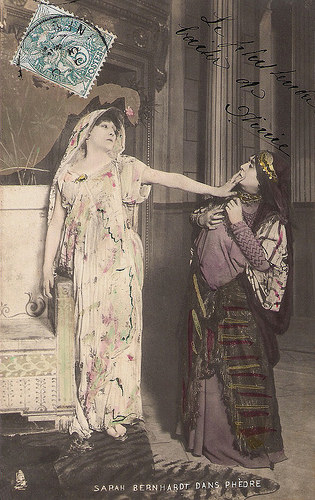
French postcard by Raphael Tuck & Fils, Editeurs, Paris, Serie 203. Sent by mail in 1903. Caption: Sarah Bernhardt in Phèdre. Bernhardt played the title rol in Jean Racine's Phèdre for the first time in 1874. She retook the part in 1899 when Bernhardt took over the former Théâtre des Nations on the Place du Châtelet. The Théâtre Sarah-Bernhardt opened on 21 January with Victorien Sardou's La Tosca in which Bernhardt played the title role, one of her most admired parts. This was followed by a revival of Phèdre on 24 February.
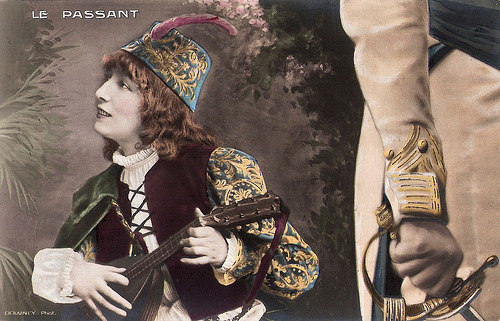
French postcard. Photo: Downey. Publicity still for the play Le Passant, by François Coppée. In 1869, after her command performance for Napoleon III as as the Florentine minstrel Zanetto (in travesty) in Coppée’s Le Passant, Sarah Bernhardt was on the verge of stardom.
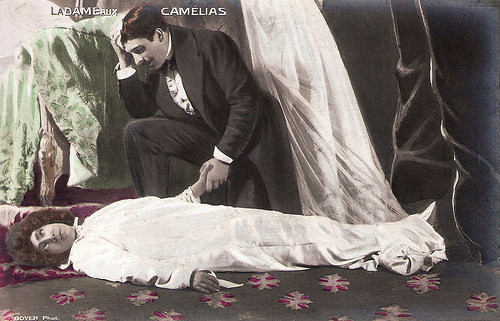
French postcard. Photo: Boyer. Sarah Bernhardt debuted in Alexandre Dumas fils's play La Dame aux Camélias in 1880. It became one of her most beloved and most performed plays. In 1911 Bernhardt would act in a silent film version as well, directed by André Calmettes and Henri Pouctal. This postcard is from the early 20th century. The card depicts the dead Marguerite Gauthier, deplored by her lover Armand Duval.
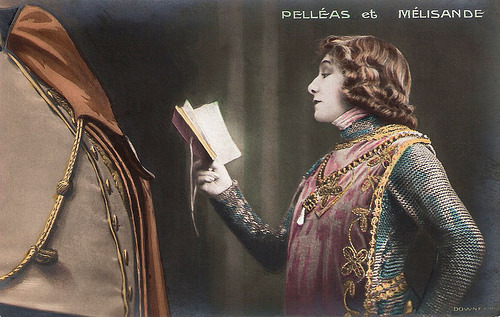
French postcard. Photo: Downey. Publicity still for the stage production of Maurice Maeterlinck's play Pelléas et Melisande/Pelléas and Melisande in 1904.
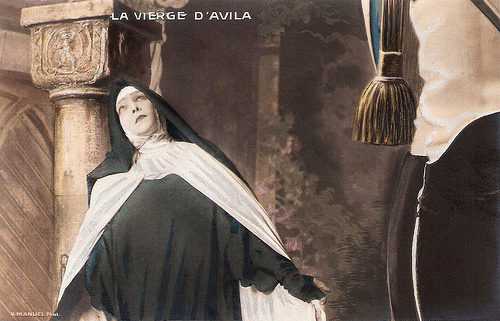
French postcard. Photo: H. Manuel. Sarah Bernhardt as Soeur Therese in the play La Vierge d'Avila composed by Reynaldo Hahn and written by Catulle Mendes. 1906 performance at Theatre Sarah-Bernhardt.
The life of a courtesan
Sarah Bernhardt was born in 1844 in Paris as Henriette-Rosine Bernard. Her mother was the Dutch-born Julie Bernardt and her father was unknown. Julie was a courtesan, known by the name Youle. Julie had five daughters, including a twin who died in infancy in 1843. Henriette-Rosine changed her first name and added an 'h' to her surname. Her birth records were lost in a fire in 1871. To prove French citizenship - necessary for Légion d'honneur eligibility - she created false birth records, in which she was the daughter of 'Judith van Hard' and 'Édouard Bernardt' from Le Havre, in later stories either a law student, accountant, naval cadet or naval officer.
When Sarah was young her mother sent her to Grandchamp, an Augustine convent school near Versailles. In 1860 she began attending the Conservatoire de musique et de déclamation in Paris and eventually became a student at the Comédie Française where she would have her acting debut in 1862 in the title role of Jean Racine's Iphigénie to lackluster reviews. Her time there was short-lived; she was asked to resign after slapping another actress across the face for shoving her younger sister during a birthday celebration for Molière.
Bernhardt decided to leave France, and soon ended up in Belgium, where she became the mistress of Henri, Prince de Ligne, and gave birth to their son, Maurice, in 1864. After Maurice's birth, the Prince proposed marriage, but his family forbade it and persuaded Bernhardt to refuse and end their relationship. She resumed the life of a courtesan to which her mother had introduced her at a young age, and made considerable amounts of money during that period (1862–1865).
Bernhardt then reverted to the theatre, securing a contract at the Théâtre de L’Odéon where she began performing in 1866. Her most famous performance there was her travesty performance as the Florentine minstrel in François Coppé's Le Passant (1869). With the outbreak of the Franco-Prussian War performances were stopped and Bernhardt converted the theatre into a makeshift hospital where she took care of the soldiers wounded on the battlefield. In 1872, she left the Odéon and returned to the Comédie-Française. One of her remarkable successes there was in the title role of Voltaire's Zaïre (1874).
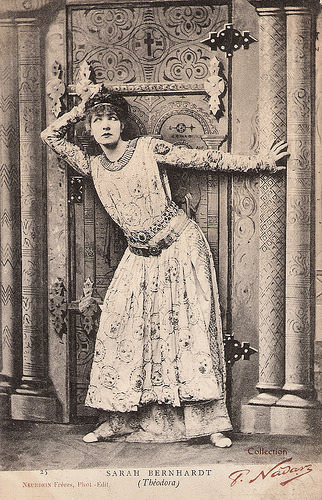
French postcard by Neurdein Frères, Photo-Edit., no. 25. Photo: Nadar. Bernhardt as Empress Theodora in Victorien Sardou’s Theodora (1884).
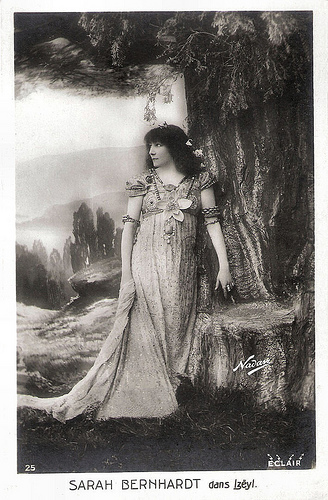
French postcard by Eclair, no. 25. Photo: Nadar. Publicity still for the 1894 stage play Izéil by Eugène Morand and Armand Silvestre.
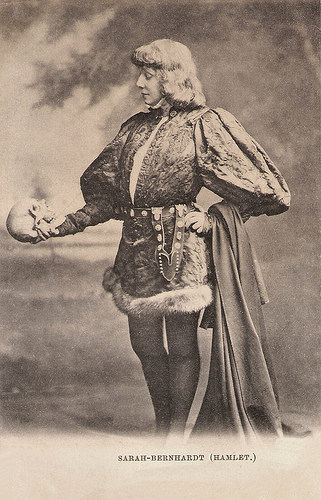
French postcard. Bernhardt in the title role of William Shakespeare's Hamlet (1899).
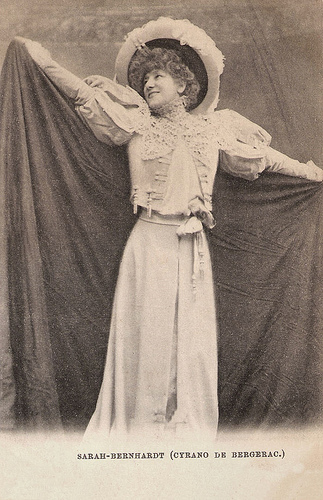
French postcard. Photo: publicity still for a 1900 production of the stage play Cyrano de Bergerac (1900) by Edmond Rostand, in which Bernhardt played the role of Roxane.
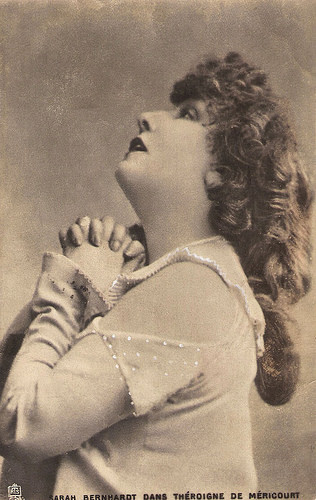
French postcard by Raphael Tuck et Fils Ltd Editeurs, Paris, Serie 569. Publicity still for the stage production of Theroigne de Mericourt (1902), a play by Paul Hervieu. Anne-Josèphe Théroigne de Méricourt (1762–1817) was a singer, orator and organizer in the French Revolution. She is known both for her portrayal in the French Revolutionary press and for her subsequent mental breakdown and institutionalization.
The Divine Sarah
During the 1870s, Sarah Bernhardt made her fame on the European stages and was soon in demand all over the world. Her first tour of the United States and Canada took place in 1880-1881 (157 performances in 31 cities). In 1887 she toured South America. In 1888 she toured Italy, Egypt, Turkey, Sweden, Norway and Russia. In 1891-1892 she took part in a worldwide tour which included much of Europe, Russia, North & South America, Australia, New Zealand, Hawaii and Samoa. Another tour of America took place in 1896. 1901 saw her 6th American Tour, 1906 her 7th (her first 'Farewell Tour'), 1910 her 8th, and 1913-1914 her 9th.
She developed a reputation as a serious dramatic actress, earning the title 'The Divine Sarah'. However, she also participated in scandalous productions such as John Wesley De Kay's Judas. In this play Mary Magdalene, who at first became a lover of Pontius Pilate, then of Judas Iscariot (played by Bernhardt!), got involved with Jesus. Judas, after realizing that Mary Magdalene had given herself to Jesus, decided to betray his friend to the Romans. The play performed in New York’s Globe Theatre for only one night in December 1910 before it was banned there, as well as in Boston and Philadelphia.
In between her international tours, Sarah Bernhardt took over the lease of the Théâtre de la Renaissance, which she ran as producer-director-star from 1893 to 1899. She coached many young women in the art of acting. In 1899 Bernhardt took over the former Théâtre des Nations on the Place du Châtelet, renaming it the Théâtre Sarah-Bernhardt. She opened it in the title role in Victorien Sardou's La Tosca and many of her famous roles, such as her Hamlet in travesty, followed.
Bernhardt continued to direct the Théâtre Sarah-Bernhardt until her death, when her son Maurice took over. After his death in 1928, the theatre retained the name Sarah Bernhardt until the Occupation by the Germans in World War II, when the name was changed to Théâtre de la Cité because of Bernhardt's Jewish ancestry.
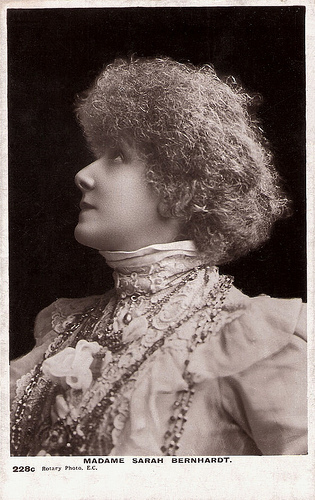
British postcard by Rotary Photo Co., London, no. 228C.
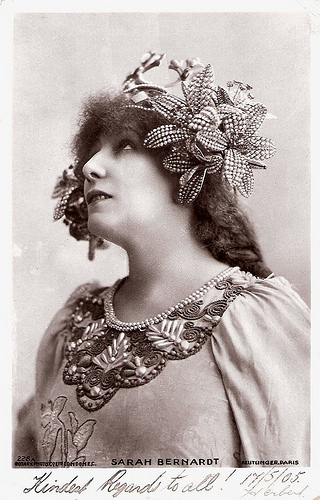
British postcard by Rotary Photo Co., London, no. 228A. Sent by mail in 1905. Photo: Reutlinger, Paris.
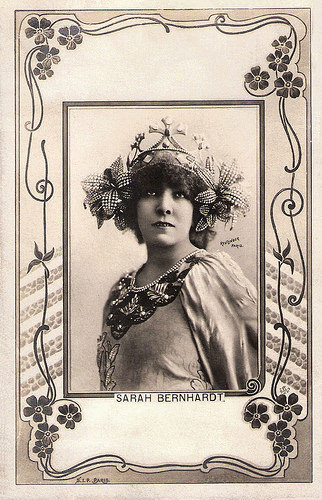
French postcard by S.I.P., Paris. Photo: Reutlinger.
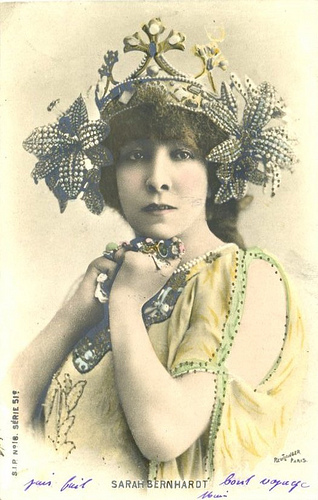
Tinted, vintage postcard. Collection: phheww.
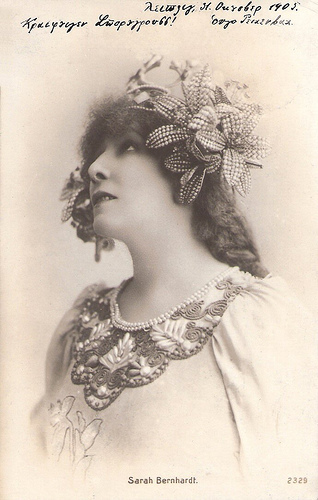
German postcard, no. 2329. It was sent from Leipzig, Germany to Laibach, Austria (now Ljubljana, Slovenia) on 31 October 1905. The author used the Greek alphabet. We deciphered the text and discovered that he wrote in German and signed as Hugo Reizenbach. The addressee was one Christl Kantz, maybe his secret girlfriend?
Sarah by Reutlinger
The beautiful postcards above are probably the best known images of Sarah Bernhardt. On each postcard she wears the same outfit and a huge crown-like diadem. This 'Lilies' diadem for was designed by poster designer Alphonse Mucha and created by the famous French jewelry designer René Lalique.
The photographs for the postcards were made by the Reutlinger Studio in Paris, which took photos of the rich and famous between 1850 and 1937. The Reutlinger studio was founded in 1850 by German-born photographer Charles Reutlinger. In 1880, he passed the studio on to his brother Emile, who ran the studio until 1890. In 1883, Emile’s son Léopold came to Paris from Callao, Peru, where he grew up. Léopold Reutlinger took over in 1890, and he developed a very successful postcard business.
P.K. Hobbs at Everything Vintage : "Léopold introduced a very distinctive style of merging photographic images with art nouveau fantasy overlays. He added to that process exceptionally well-done hand tinting. The Reutlinger Studio became known for their unusual art nouveau styles of postcard designs, especially for portraits of actresses. These postcards were not cheaply produced, nor were they cheaply sold. This part of his business was very successful and sought-after, as thousands of his art nouveau postcards were produced."
The photos for the postcards above were publicity stills for the stage play La princesse Lointaine by Edmond Rostand. Sarah Bernhardt wore the diadem for the first time in this play at the Renaissance Theatre in Paris in 1895.
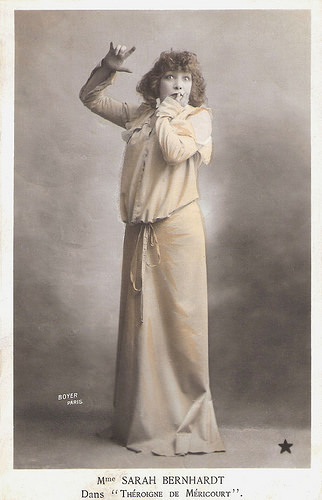
French postcard. Sent by mail in 1906. Photo: Boyer, Paris. Publicity still for the play Théroigne de Méricourt, by M. Paul Hervieu, prsented at the Théâtre Sarah Bernhardt in 1902.
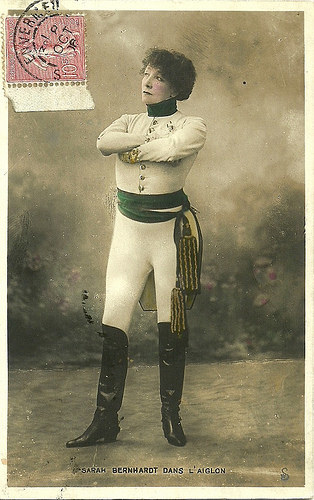
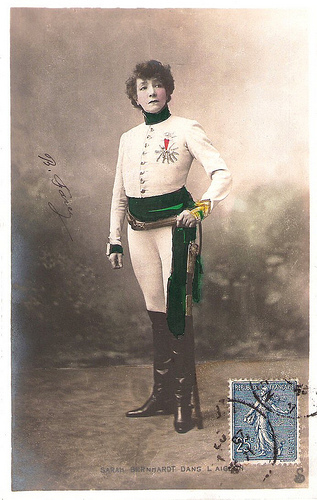
French postcards, both sent by mail in 1908. Photos: publicity stills for her stage play L'aiglon.
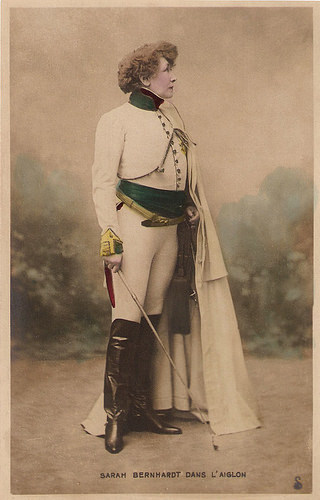
French postcard. Photo: Sarah Bernhardt in L'Aiglon. L'Aiglon is a play in six acts by Edmond Rostand based on the life of Napoleon II, who was the son of Emperor Napoleon I and his second wife, Empress Marie Louise. The title of the play comes from a nickname for Napoleon II, the French word for 'eaglet' (a young eagle). The title role was created by Sarah Bernhardt in the play's premiere on 15 March 1900 at the Théàtre Sarah Bernhardt. Rostand had written L'Aiglon specifically for Bernhardt, and it became one of her signature roles.
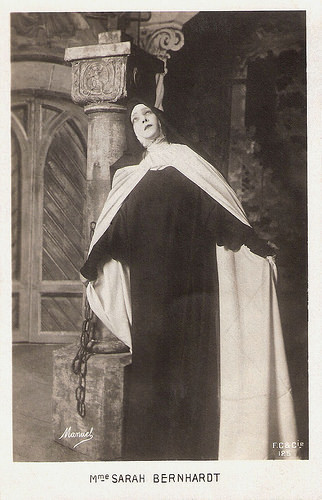
French postcard by F.C. & Cie, no. 125. Photo: Manuel. Sarah Bernhardt as Soeur Therese in La Vierge d'Avila composed by Reynaldo Hahn and written by Catulle Mendes. 1906.
A sporadic love-hate affair with cinema
Sarah Bernhardt had a sporadic love-hate affair with the early cinema. In 1900, she made her first film, the two-minute long Le Duel d'Hamlet/Hamlet (Clément Maurice, 1900). Technically, this was not a silent film, as it had an accompanying Edison cylinder with sound effects.
After her film début Bernhardt declared she detested the medium. However, in the following decades she consented to star in eight motion pictures and two biographical films. The latter included Sarah Bernhardt à Belle-Isle/Sarah Bernhardt at Home (1912), a film about her daily life with her family and friends.
In 1908 she featured in her second film, based on Victorien Sardou's Tosca, condensed to a one-reel film. Upon seeing La Tosca (1909), she reportedly recoiled in horror, demanding that the negative be destroyed.
Nevertheless, soon followed her leading role in the Film d'Art production La dame aux camélias/Lady of the Camelias (Louis Mercanton, 1911), released in the US as Camille. It was a two-reel condensation of the play with handsome Dutch actor Lou Tellegen as Armand Duval. The film was a critical and popular success, and it helped to give the cinema artistic dignity.
The handsome Dutch-born Lou Tellegen was again Bernhardt's co-star in her next film, Les amours de la reine Élisabeth/Queen Elisabeth (Henri Desfontaines, Louis Mercanton, 1912), filmed in Britain. The massive receipts from this film's distribution in the US provided Adolph Zukor with the funds to found Paramount.
Bernhardt, at 69, was offered a fortune to make films with other companies, but she stayed with Film d'Art. She next appeared in Adrienne Lecouvreur (Henri Desfontaines, Louis Mercanton, 1913) with Max Maxudian and again Lou Tellegen .
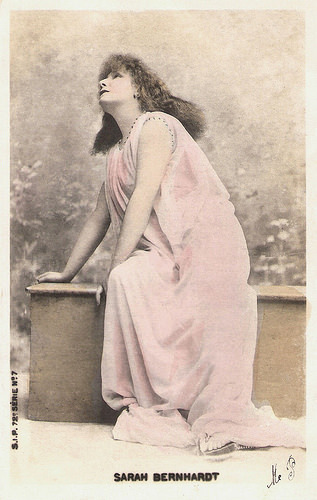
French postcard by S.I.P., 72e Serie, no. 7.
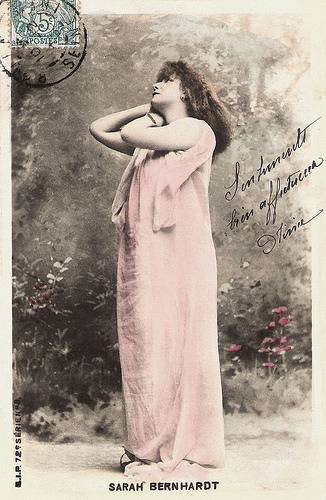
French postcard by S.I.P., series 72, no. 8.
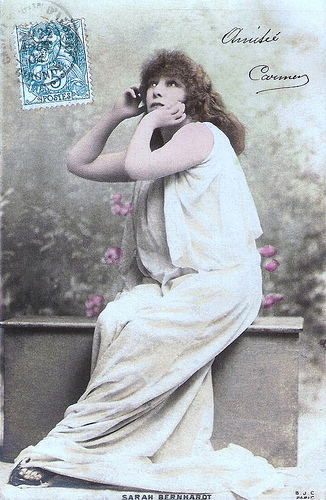
French postcard by BJC, Paris. Sent by mail in 1904.
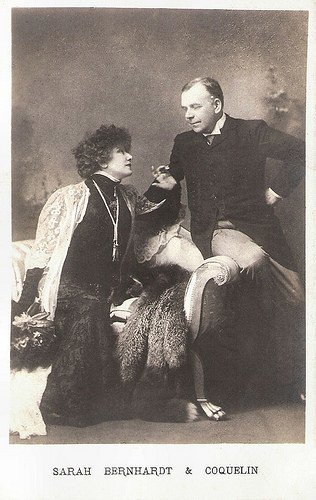
French postcard. Sarah Bernhardt and colleague Benoît-Constant Coquelin, known as Coquelin aîné (Coquelin the Eldest), known as one of the greatest theatrical figures of the age. In 1900 Bernahardt and Coquelin toured together in America. They appeared on Broadway's Garden Theatre in a production of Cyrano de Bergerac (Coquelin as Cyrano and Bernhardt as Roxane). On their return to France they appear together in L'Aiglon, at the Théâtre Sarah Bernhardt.
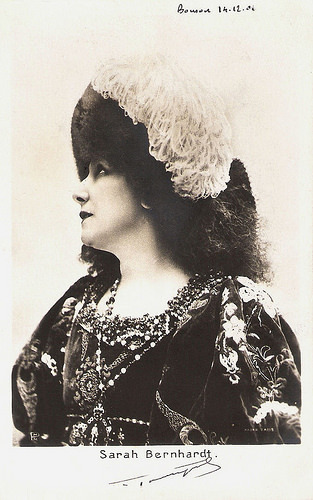
French postcard by PMM. Photo: Nadar, Paris. Sent by mail in 1901.
War propaganda films
During the First World War, Sarah Bernhardt played in two war propaganda films, the intimate drama Jeanne Doré (René Hervil, Louis Mercanton, 1915) and the highly patriotic Mères françaises/Mothers of France (René Hervil, Louis Mercanton, 1917).
In between these two films, she had lost a leg. In 1905, while performing in Victorien Sardou's La Tosca in Teatro Lírico do Rio de Janeiro, Bernhardt injured her right knee when jumping off the parapet in the final scene. The leg never healed properly. By 1915, gangrene set in and her entire right leg was amputated; she was required to use a wheelchair for several months.
Bernhardt continued her career, sometimes without using a wooden prosthetic limb, which she did not like. She carried out a successful tour of America in 1917 (her 10th), and on returning to France she played in her own productions almost continuously until her death. Later successes included Daniel (1920), La Gloire (1921), and Régine Armand (1922). The amputation was not apparent during her performances, which were done with the use of the artificial limb. The charm of her voice, which had altered little with age, ensured her triumphs.
Her last film was La Voyante/The Fortune Teller (Leon Abrams, Louis Mercanton, 1923) with Harry Baur . By then she was 79 and already mortally ill. Her hotel room was turned into a studio. But her failing health halted production and she died before the film was completed. Her stand-in had to complete her scenes, with her back to the camera.
Sarah Bernhardt passed away on 26 March 1923 in Paris. The cause of death was uremia (urea in the blood) following after kidney failure. From 1882 till 1898 (his death), she had been married to the Greek diplomat Ambroise Aristide Damala, who was 12 years younger than his wife. Newspaper reports stated she died "peacefully, without suffering, in the arms of her son". She is believed to have been 79 years old. Sarah Bernhardt is buried at the Cimetière du Père Lachaise.
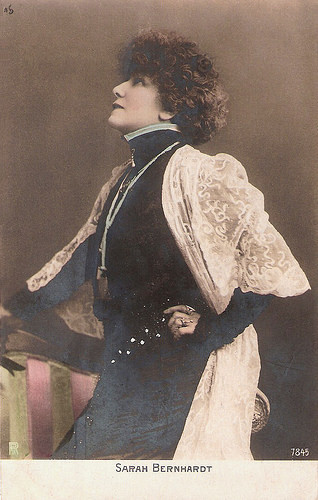
German postcard, no. 7845.
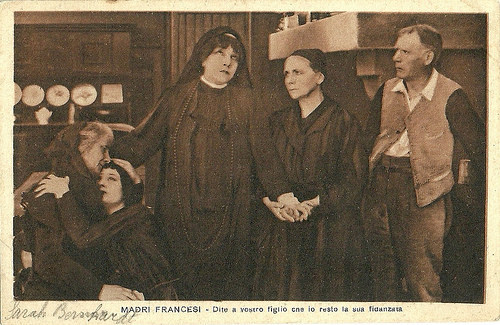
Italian postcard. Sarah Bernhardt as Mme D'Urbex and Louise Lagrange as Marie in the French war propaganda film Mères françaises (René Hervil, Louis Mercanton, 1917). Caption: Tell your son I will remain his fiancée.
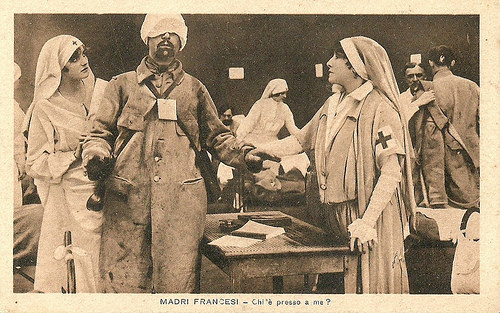
Italian postcard. Sarah Bernhardt as Mme D'Urbex and Gabriel Signoret as Guinot in the French war propaganda film Mères françaises (René Hervil, Louis Mercanton, 1917). Caption: Who is near me?

Italian postcard. Sarah Bernhardt as Mme D'Urbex and Gabriel Signoret as Guinot in the French war propaganda film Mères françaises (René Hervil, Louis Mercanton, 1917). Caption: The schoolmaster returns to his class, which henceforth will be his reason to live.
Sequence from Les amours de la reine Élisabeth/Queen Elisabeth (1912). Robert Devereux, the 2nd Earl of Essex ( Lou Tellegen ) has been executed. Queen Elizabeth (Sarah Bernhardt) visits his corpse, and mourns for him. Source: swagner99 (YouTube).
Sources: (IMDb), P.K. Hobbs (Everything Vintage), Victor (Wonderings), Wikipedia and .

French postcard by Raphael Tuck & Fils, Editeurs, Paris, Serie 203. Sent by mail in 1903. Caption: Sarah Bernhardt in Phèdre. Bernhardt played the title rol in Jean Racine's Phèdre for the first time in 1874. She retook the part in 1899 when Bernhardt took over the former Théâtre des Nations on the Place du Châtelet. The Théâtre Sarah-Bernhardt opened on 21 January with Victorien Sardou's La Tosca in which Bernhardt played the title role, one of her most admired parts. This was followed by a revival of Phèdre on 24 February.

French postcard. Photo: Downey. Publicity still for the play Le Passant, by François Coppée. In 1869, after her command performance for Napoleon III as as the Florentine minstrel Zanetto (in travesty) in Coppée’s Le Passant, Sarah Bernhardt was on the verge of stardom.

French postcard. Photo: Boyer. Sarah Bernhardt debuted in Alexandre Dumas fils's play La Dame aux Camélias in 1880. It became one of her most beloved and most performed plays. In 1911 Bernhardt would act in a silent film version as well, directed by André Calmettes and Henri Pouctal. This postcard is from the early 20th century. The card depicts the dead Marguerite Gauthier, deplored by her lover Armand Duval.

French postcard. Photo: Downey. Publicity still for the stage production of Maurice Maeterlinck's play Pelléas et Melisande/Pelléas and Melisande in 1904.

French postcard. Photo: H. Manuel. Sarah Bernhardt as Soeur Therese in the play La Vierge d'Avila composed by Reynaldo Hahn and written by Catulle Mendes. 1906 performance at Theatre Sarah-Bernhardt.
The life of a courtesan
Sarah Bernhardt was born in 1844 in Paris as Henriette-Rosine Bernard. Her mother was the Dutch-born Julie Bernardt and her father was unknown. Julie was a courtesan, known by the name Youle. Julie had five daughters, including a twin who died in infancy in 1843. Henriette-Rosine changed her first name and added an 'h' to her surname. Her birth records were lost in a fire in 1871. To prove French citizenship - necessary for Légion d'honneur eligibility - she created false birth records, in which she was the daughter of 'Judith van Hard' and 'Édouard Bernardt' from Le Havre, in later stories either a law student, accountant, naval cadet or naval officer.
When Sarah was young her mother sent her to Grandchamp, an Augustine convent school near Versailles. In 1860 she began attending the Conservatoire de musique et de déclamation in Paris and eventually became a student at the Comédie Française where she would have her acting debut in 1862 in the title role of Jean Racine's Iphigénie to lackluster reviews. Her time there was short-lived; she was asked to resign after slapping another actress across the face for shoving her younger sister during a birthday celebration for Molière.
Bernhardt decided to leave France, and soon ended up in Belgium, where she became the mistress of Henri, Prince de Ligne, and gave birth to their son, Maurice, in 1864. After Maurice's birth, the Prince proposed marriage, but his family forbade it and persuaded Bernhardt to refuse and end their relationship. She resumed the life of a courtesan to which her mother had introduced her at a young age, and made considerable amounts of money during that period (1862–1865).
Bernhardt then reverted to the theatre, securing a contract at the Théâtre de L’Odéon where she began performing in 1866. Her most famous performance there was her travesty performance as the Florentine minstrel in François Coppé's Le Passant (1869). With the outbreak of the Franco-Prussian War performances were stopped and Bernhardt converted the theatre into a makeshift hospital where she took care of the soldiers wounded on the battlefield. In 1872, she left the Odéon and returned to the Comédie-Française. One of her remarkable successes there was in the title role of Voltaire's Zaïre (1874).

French postcard by Neurdein Frères, Photo-Edit., no. 25. Photo: Nadar. Bernhardt as Empress Theodora in Victorien Sardou’s Theodora (1884).

French postcard by Eclair, no. 25. Photo: Nadar. Publicity still for the 1894 stage play Izéil by Eugène Morand and Armand Silvestre.

French postcard. Bernhardt in the title role of William Shakespeare's Hamlet (1899).

French postcard. Photo: publicity still for a 1900 production of the stage play Cyrano de Bergerac (1900) by Edmond Rostand, in which Bernhardt played the role of Roxane.

French postcard by Raphael Tuck et Fils Ltd Editeurs, Paris, Serie 569. Publicity still for the stage production of Theroigne de Mericourt (1902), a play by Paul Hervieu. Anne-Josèphe Théroigne de Méricourt (1762–1817) was a singer, orator and organizer in the French Revolution. She is known both for her portrayal in the French Revolutionary press and for her subsequent mental breakdown and institutionalization.
The Divine Sarah
During the 1870s, Sarah Bernhardt made her fame on the European stages and was soon in demand all over the world. Her first tour of the United States and Canada took place in 1880-1881 (157 performances in 31 cities). In 1887 she toured South America. In 1888 she toured Italy, Egypt, Turkey, Sweden, Norway and Russia. In 1891-1892 she took part in a worldwide tour which included much of Europe, Russia, North & South America, Australia, New Zealand, Hawaii and Samoa. Another tour of America took place in 1896. 1901 saw her 6th American Tour, 1906 her 7th (her first 'Farewell Tour'), 1910 her 8th, and 1913-1914 her 9th.
She developed a reputation as a serious dramatic actress, earning the title 'The Divine Sarah'. However, she also participated in scandalous productions such as John Wesley De Kay's Judas. In this play Mary Magdalene, who at first became a lover of Pontius Pilate, then of Judas Iscariot (played by Bernhardt!), got involved with Jesus. Judas, after realizing that Mary Magdalene had given herself to Jesus, decided to betray his friend to the Romans. The play performed in New York’s Globe Theatre for only one night in December 1910 before it was banned there, as well as in Boston and Philadelphia.
In between her international tours, Sarah Bernhardt took over the lease of the Théâtre de la Renaissance, which she ran as producer-director-star from 1893 to 1899. She coached many young women in the art of acting. In 1899 Bernhardt took over the former Théâtre des Nations on the Place du Châtelet, renaming it the Théâtre Sarah-Bernhardt. She opened it in the title role in Victorien Sardou's La Tosca and many of her famous roles, such as her Hamlet in travesty, followed.
Bernhardt continued to direct the Théâtre Sarah-Bernhardt until her death, when her son Maurice took over. After his death in 1928, the theatre retained the name Sarah Bernhardt until the Occupation by the Germans in World War II, when the name was changed to Théâtre de la Cité because of Bernhardt's Jewish ancestry.

British postcard by Rotary Photo Co., London, no. 228C.

British postcard by Rotary Photo Co., London, no. 228A. Sent by mail in 1905. Photo: Reutlinger, Paris.

French postcard by S.I.P., Paris. Photo: Reutlinger.

Tinted, vintage postcard. Collection: phheww.

German postcard, no. 2329. It was sent from Leipzig, Germany to Laibach, Austria (now Ljubljana, Slovenia) on 31 October 1905. The author used the Greek alphabet. We deciphered the text and discovered that he wrote in German and signed as Hugo Reizenbach. The addressee was one Christl Kantz, maybe his secret girlfriend?
Sarah by Reutlinger
The beautiful postcards above are probably the best known images of Sarah Bernhardt. On each postcard she wears the same outfit and a huge crown-like diadem. This 'Lilies' diadem for was designed by poster designer Alphonse Mucha and created by the famous French jewelry designer René Lalique.
The photographs for the postcards were made by the Reutlinger Studio in Paris, which took photos of the rich and famous between 1850 and 1937. The Reutlinger studio was founded in 1850 by German-born photographer Charles Reutlinger. In 1880, he passed the studio on to his brother Emile, who ran the studio until 1890. In 1883, Emile’s son Léopold came to Paris from Callao, Peru, where he grew up. Léopold Reutlinger took over in 1890, and he developed a very successful postcard business.
P.K. Hobbs at Everything Vintage : "Léopold introduced a very distinctive style of merging photographic images with art nouveau fantasy overlays. He added to that process exceptionally well-done hand tinting. The Reutlinger Studio became known for their unusual art nouveau styles of postcard designs, especially for portraits of actresses. These postcards were not cheaply produced, nor were they cheaply sold. This part of his business was very successful and sought-after, as thousands of his art nouveau postcards were produced."
The photos for the postcards above were publicity stills for the stage play La princesse Lointaine by Edmond Rostand. Sarah Bernhardt wore the diadem for the first time in this play at the Renaissance Theatre in Paris in 1895.

French postcard. Sent by mail in 1906. Photo: Boyer, Paris. Publicity still for the play Théroigne de Méricourt, by M. Paul Hervieu, prsented at the Théâtre Sarah Bernhardt in 1902.


French postcards, both sent by mail in 1908. Photos: publicity stills for her stage play L'aiglon.

French postcard. Photo: Sarah Bernhardt in L'Aiglon. L'Aiglon is a play in six acts by Edmond Rostand based on the life of Napoleon II, who was the son of Emperor Napoleon I and his second wife, Empress Marie Louise. The title of the play comes from a nickname for Napoleon II, the French word for 'eaglet' (a young eagle). The title role was created by Sarah Bernhardt in the play's premiere on 15 March 1900 at the Théàtre Sarah Bernhardt. Rostand had written L'Aiglon specifically for Bernhardt, and it became one of her signature roles.

French postcard by F.C. & Cie, no. 125. Photo: Manuel. Sarah Bernhardt as Soeur Therese in La Vierge d'Avila composed by Reynaldo Hahn and written by Catulle Mendes. 1906.
A sporadic love-hate affair with cinema
Sarah Bernhardt had a sporadic love-hate affair with the early cinema. In 1900, she made her first film, the two-minute long Le Duel d'Hamlet/Hamlet (Clément Maurice, 1900). Technically, this was not a silent film, as it had an accompanying Edison cylinder with sound effects.
After her film début Bernhardt declared she detested the medium. However, in the following decades she consented to star in eight motion pictures and two biographical films. The latter included Sarah Bernhardt à Belle-Isle/Sarah Bernhardt at Home (1912), a film about her daily life with her family and friends.
In 1908 she featured in her second film, based on Victorien Sardou's Tosca, condensed to a one-reel film. Upon seeing La Tosca (1909), she reportedly recoiled in horror, demanding that the negative be destroyed.
Nevertheless, soon followed her leading role in the Film d'Art production La dame aux camélias/Lady of the Camelias (Louis Mercanton, 1911), released in the US as Camille. It was a two-reel condensation of the play with handsome Dutch actor Lou Tellegen as Armand Duval. The film was a critical and popular success, and it helped to give the cinema artistic dignity.
The handsome Dutch-born Lou Tellegen was again Bernhardt's co-star in her next film, Les amours de la reine Élisabeth/Queen Elisabeth (Henri Desfontaines, Louis Mercanton, 1912), filmed in Britain. The massive receipts from this film's distribution in the US provided Adolph Zukor with the funds to found Paramount.
Bernhardt, at 69, was offered a fortune to make films with other companies, but she stayed with Film d'Art. She next appeared in Adrienne Lecouvreur (Henri Desfontaines, Louis Mercanton, 1913) with Max Maxudian and again Lou Tellegen .

French postcard by S.I.P., 72e Serie, no. 7.

French postcard by S.I.P., series 72, no. 8.

French postcard by BJC, Paris. Sent by mail in 1904.

French postcard. Sarah Bernhardt and colleague Benoît-Constant Coquelin, known as Coquelin aîné (Coquelin the Eldest), known as one of the greatest theatrical figures of the age. In 1900 Bernahardt and Coquelin toured together in America. They appeared on Broadway's Garden Theatre in a production of Cyrano de Bergerac (Coquelin as Cyrano and Bernhardt as Roxane). On their return to France they appear together in L'Aiglon, at the Théâtre Sarah Bernhardt.

French postcard by PMM. Photo: Nadar, Paris. Sent by mail in 1901.
War propaganda films
During the First World War, Sarah Bernhardt played in two war propaganda films, the intimate drama Jeanne Doré (René Hervil, Louis Mercanton, 1915) and the highly patriotic Mères françaises/Mothers of France (René Hervil, Louis Mercanton, 1917).
In between these two films, she had lost a leg. In 1905, while performing in Victorien Sardou's La Tosca in Teatro Lírico do Rio de Janeiro, Bernhardt injured her right knee when jumping off the parapet in the final scene. The leg never healed properly. By 1915, gangrene set in and her entire right leg was amputated; she was required to use a wheelchair for several months.
Bernhardt continued her career, sometimes without using a wooden prosthetic limb, which she did not like. She carried out a successful tour of America in 1917 (her 10th), and on returning to France she played in her own productions almost continuously until her death. Later successes included Daniel (1920), La Gloire (1921), and Régine Armand (1922). The amputation was not apparent during her performances, which were done with the use of the artificial limb. The charm of her voice, which had altered little with age, ensured her triumphs.
Her last film was La Voyante/The Fortune Teller (Leon Abrams, Louis Mercanton, 1923) with Harry Baur . By then she was 79 and already mortally ill. Her hotel room was turned into a studio. But her failing health halted production and she died before the film was completed. Her stand-in had to complete her scenes, with her back to the camera.
Sarah Bernhardt passed away on 26 March 1923 in Paris. The cause of death was uremia (urea in the blood) following after kidney failure. From 1882 till 1898 (his death), she had been married to the Greek diplomat Ambroise Aristide Damala, who was 12 years younger than his wife. Newspaper reports stated she died "peacefully, without suffering, in the arms of her son". She is believed to have been 79 years old. Sarah Bernhardt is buried at the Cimetière du Père Lachaise.

German postcard, no. 7845.

Italian postcard. Sarah Bernhardt as Mme D'Urbex and Louise Lagrange as Marie in the French war propaganda film Mères françaises (René Hervil, Louis Mercanton, 1917). Caption: Tell your son I will remain his fiancée.

Italian postcard. Sarah Bernhardt as Mme D'Urbex and Gabriel Signoret as Guinot in the French war propaganda film Mères françaises (René Hervil, Louis Mercanton, 1917). Caption: Who is near me?

Italian postcard. Sarah Bernhardt as Mme D'Urbex and Gabriel Signoret as Guinot in the French war propaganda film Mères françaises (René Hervil, Louis Mercanton, 1917). Caption: The schoolmaster returns to his class, which henceforth will be his reason to live.
Sequence from Les amours de la reine Élisabeth/Queen Elisabeth (1912). Robert Devereux, the 2nd Earl of Essex ( Lou Tellegen ) has been executed. Queen Elizabeth (Sarah Bernhardt) visits his corpse, and mourns for him. Source: swagner99 (YouTube).
Sources: (IMDb), P.K. Hobbs (Everything Vintage), Victor (Wonderings), Wikipedia and .
Published on September 09, 2016 22:00
September 8, 2016
EFSP's Dazzling Dozen: Roundabout
Let's play, this Postcard Friendship Friday. Do you know the French film La Ronde? It's a film directed in 1950 by Max Ophüls and based on Arthur Schnitzler's 1897 play Reigen. The film title is often translated as Roundabout. The episodes of the novel and the film are about illicit sexual encounters, and after each encounter, one of the two partners forms a liaison with the next person, resulting in an unbroken circle (ronde) by the end. So let's go roundabout with film partners postcards.
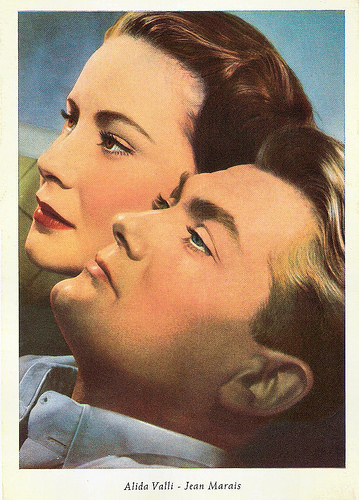
Jean Marais and Alida Valli . German postcard by Wilhelm Schulze-Witteburg Graphischer Betrieb (WS-Druck), Wanne Eickel. Photo: Deutsche Commerz Film GmbH. Publicity still for Les Miracles n'ont lieu qu'une fois/Miracles Only Happen Once (Yves Allégret, 1951).
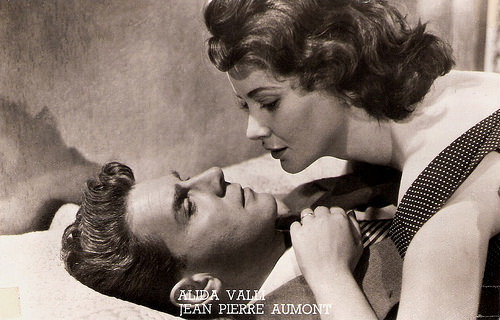
Alida Valli and Jean-Pierre Aumont . Vintage Postcard, no. 952. Publicity still for Ultimo incontro/Last Meeting (Gianni Franciolini, 1951).
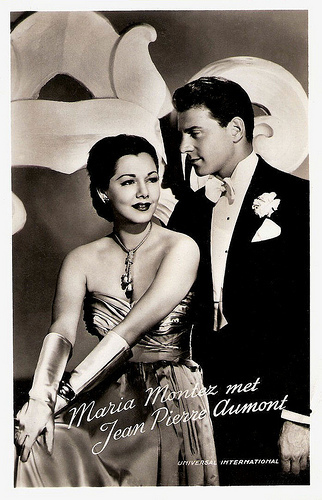
Jean Pierre Aumont and Maria Montez . Dutch postcard, no. 3117. Photo: Universal International.
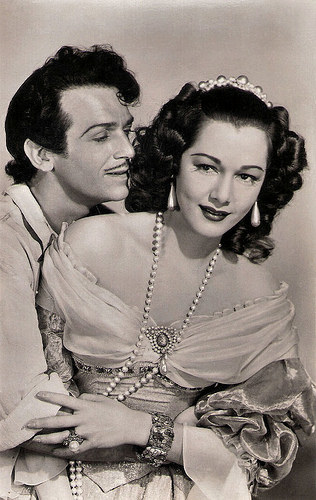
Maria Montez and Douglas Fairbanks Jr. Spanish postcard by Sobe, no. 452. Photo: publicity still for The Exile (Max Ophüls, 1947).
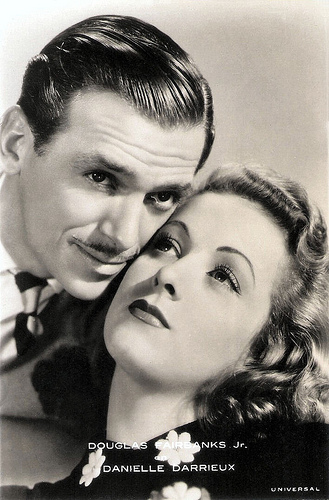
Douglas Fairbanks Jr. and Danielle Darrieux . Dutch postcard by Sparo. Photo: Universal. Publicity still for The Rage of Paris (Henry Koster, 1938).
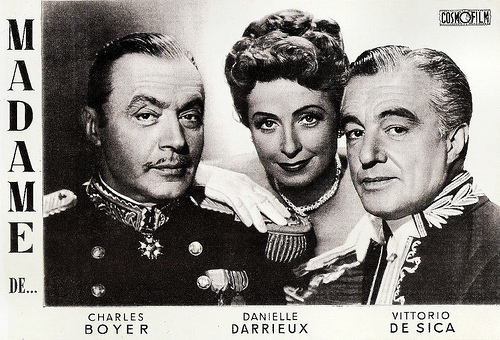
Danielle Darrieux and (right) Vittorio De Sica . Spanish promotion card by Cosmofilm. Photo: publicity still for Madame de... (Max Ophüls, 1953).
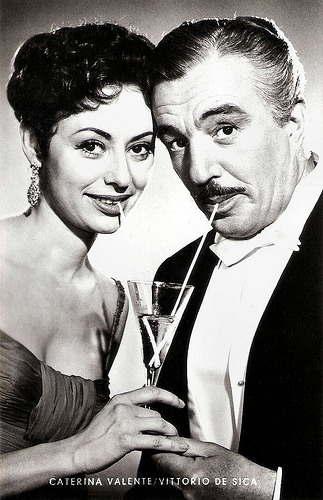
Vittorio De Sica and Caterina Valente. German postcard by Netter's Star Verlag, Berlin. Photo: publicity still for Casino de Paris (André Hunebelle, 1957).
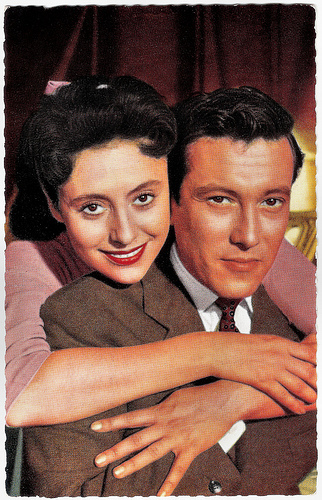
Caterina Valente and Dietmar Schönherr . German postcard by Kolibri-Verlag, Minden/Westf., no. F 32. Photo: Ringpress / Vogelmann. Publicity still for Bonjour Kathrin (Karl Anton, 1956).
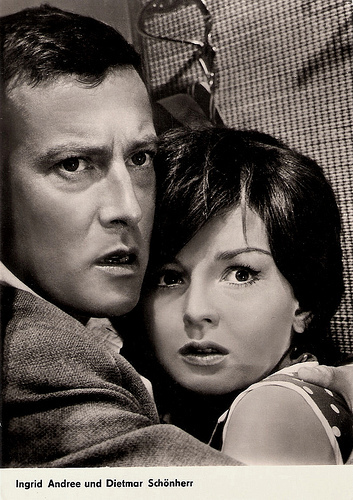
Dietmar Schönherr and Ingrid Andree . East-German postcard by VEB Progress Film-Vertrieb, Berlin., no. 1847, 1963. Retail price: 0,20 DM. Photo: publicity still for Treibjagd auf ein Leben/Drive on a life (Ralph Lothar, 1961).
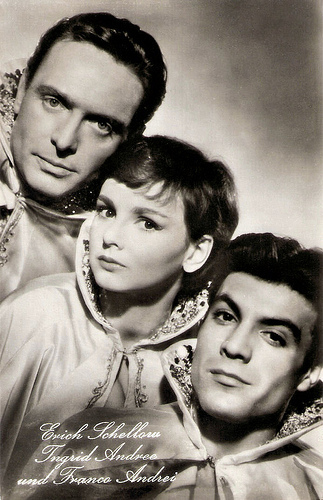
Ingrid Andree and Franco Andrei . East-German postcard by VEB Progress Film-Vertrieb, Berlin, no. 222, 1957. Photo: Standard-film, Wien. Publicity still for Drei vom Variété/Three from Variety (Kurt Neumann, 1954).
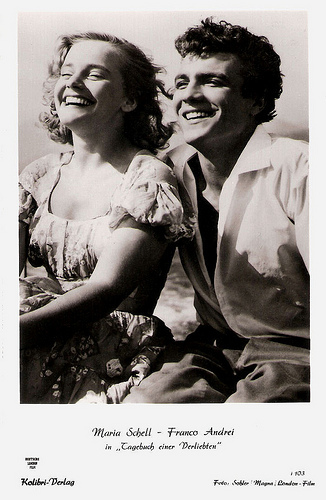
Franco Andrei and Maria Schell . German postcard by Kolibri-Verlag, no. I 103. Photo: Sohler / Magna / London-Film. Publicity still for Tagebuch einer Verliebten/The Diary of a Married Woman (Josef von Báky, 1953).
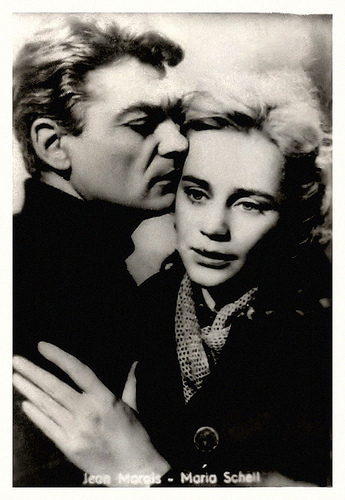
Maria Schell and Jean Marais . Photocard. Publicity still for Le notti bianche/White Nights (Luchino Visconti, 1957).
Source: Wikipedia.
This is a post for Postcard Friendship Friday, hosted by Beth at the The Best Hearts are Crunchy. You can visit her by clicking on the button below.


Jean Marais and Alida Valli . German postcard by Wilhelm Schulze-Witteburg Graphischer Betrieb (WS-Druck), Wanne Eickel. Photo: Deutsche Commerz Film GmbH. Publicity still for Les Miracles n'ont lieu qu'une fois/Miracles Only Happen Once (Yves Allégret, 1951).

Alida Valli and Jean-Pierre Aumont . Vintage Postcard, no. 952. Publicity still for Ultimo incontro/Last Meeting (Gianni Franciolini, 1951).

Jean Pierre Aumont and Maria Montez . Dutch postcard, no. 3117. Photo: Universal International.

Maria Montez and Douglas Fairbanks Jr. Spanish postcard by Sobe, no. 452. Photo: publicity still for The Exile (Max Ophüls, 1947).

Douglas Fairbanks Jr. and Danielle Darrieux . Dutch postcard by Sparo. Photo: Universal. Publicity still for The Rage of Paris (Henry Koster, 1938).

Danielle Darrieux and (right) Vittorio De Sica . Spanish promotion card by Cosmofilm. Photo: publicity still for Madame de... (Max Ophüls, 1953).

Vittorio De Sica and Caterina Valente. German postcard by Netter's Star Verlag, Berlin. Photo: publicity still for Casino de Paris (André Hunebelle, 1957).

Caterina Valente and Dietmar Schönherr . German postcard by Kolibri-Verlag, Minden/Westf., no. F 32. Photo: Ringpress / Vogelmann. Publicity still for Bonjour Kathrin (Karl Anton, 1956).

Dietmar Schönherr and Ingrid Andree . East-German postcard by VEB Progress Film-Vertrieb, Berlin., no. 1847, 1963. Retail price: 0,20 DM. Photo: publicity still for Treibjagd auf ein Leben/Drive on a life (Ralph Lothar, 1961).

Ingrid Andree and Franco Andrei . East-German postcard by VEB Progress Film-Vertrieb, Berlin, no. 222, 1957. Photo: Standard-film, Wien. Publicity still for Drei vom Variété/Three from Variety (Kurt Neumann, 1954).

Franco Andrei and Maria Schell . German postcard by Kolibri-Verlag, no. I 103. Photo: Sohler / Magna / London-Film. Publicity still for Tagebuch einer Verliebten/The Diary of a Married Woman (Josef von Báky, 1953).

Maria Schell and Jean Marais . Photocard. Publicity still for Le notti bianche/White Nights (Luchino Visconti, 1957).
Source: Wikipedia.
This is a post for Postcard Friendship Friday, hosted by Beth at the The Best Hearts are Crunchy. You can visit her by clicking on the button below.

Published on September 08, 2016 22:00
September 7, 2016
Ornella Muti
Beautiful Italian actress Ornella Muti (1955) often appeared in sexy Italian comedies and dramas, but she also worked for such major European directors as Marco Ferreri, Francesco Rosi and Volker Schlöndorff. English language audiences probably know her best as the sensuous Princess Aura in Flash Gordon (1980).
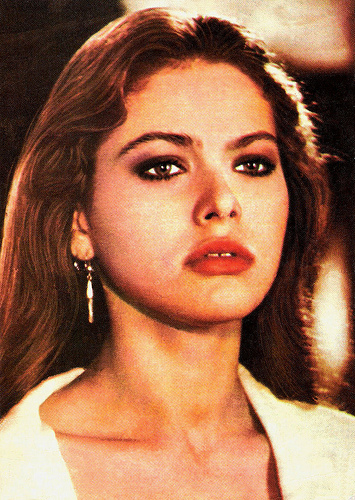
Romanian postcard by Casa Filmului Acin.
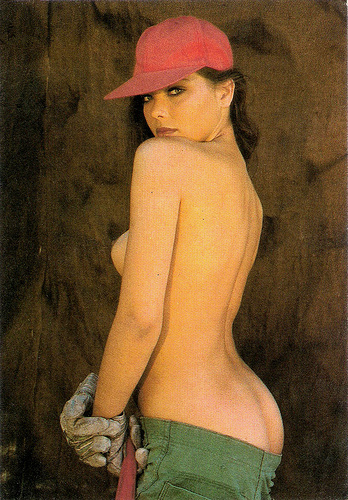
French postcard, 1982, sent by mail in 1985. Photo: Angelo Frontoni.

French postcard by Humour a a la Carte, Paris, no. ST-150.
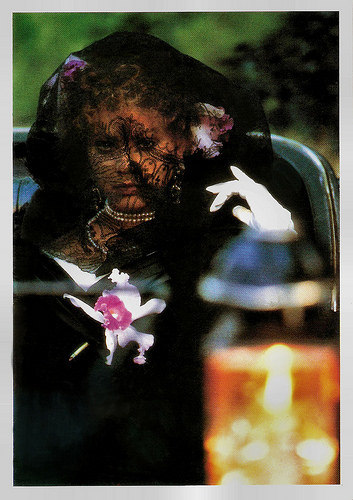
French postcard in the series Collection Cinéma Couleur by Editions La Malibran, Paris / Nancy, no. MC 34. Photo: Georges Pierre. Publicity still for Un amour de Swann/Swann in Love (Volker Schlöndorff, 1983).
The Best Filled Thing From Italy Since Ravioli
Ornella Muti was born in Rome in 1955 as Francesca Romana Rivelli, to a Neapolitan father, a journalist, and an Estonian mother, a sculptor. She has an older sister, Claudia Rivera, who was a soap actress in the 1970s.
As a teenager, the beauty with the cat-like blue eyes modelled and posed for illustrated novels. At 15, she made her film debut in the romantic melodrama La moglie più bella/The Most Beautiful Wife (Damiano Damiani, 1970).
In the following years she starred in such Giallos (Italian erotic thrillers) as Un posto ideale per uccidere/Oasis of Fear (Umberto Lenzi, 1971) with Irene Papas , and erotic dramas as Appasionata/Passionate (Gian Luigi Calderone, 1974) with Valentina Cortese . In Romanzo popolare/Come Home and Meet My Wife (Mario Monicelli, 1974) she married her 33-year older godfather ( Ugo Tognazi ).
Her international breakthrough was as the girlfriend of Gérard Depardieu in Marco Ferreri’s shocking psychological drama La dernière femme/The Last Woman (Marco Ferreri, 1976) about a man who mutilates himself drastically when the custody of his nine-month old son is threatened.
The role lead to more interesting films with well known directors including La Stanza Del Vescovo/The Bishop's Bedroom (Dino Risi, 1977) opposite Ugo Tognazi , Ritratto di Borghesia in Nero/Nest of Vipers (Tonino Cervi, 1977) with Senta Berger , and in France, Muti starred with Alain Delon in the crime thriller Mort d'un Pourri/Death of a Corrupt Man (George Lautner, 1977).
I Nuovi Mostri/Viva Italia (Mario Monicelli, Dino Risi, Ettore Scola, 1979) with Vittorio Gassman, was a black comedy, comprised of nine short stories all related to the theme that most men are selfish cads. The film was nominated for the Oscar for Best Foreign film. In America the film was promoted by a poster with Muti in swimsuit and a critic’s quote: “Ornella Muti is the best filled thing from Italy since ravioli”.
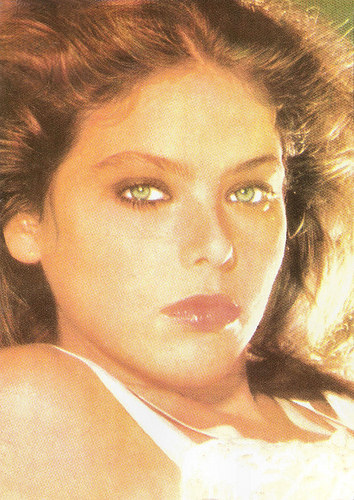
Romanian postcard by Casa Filmului Acin.
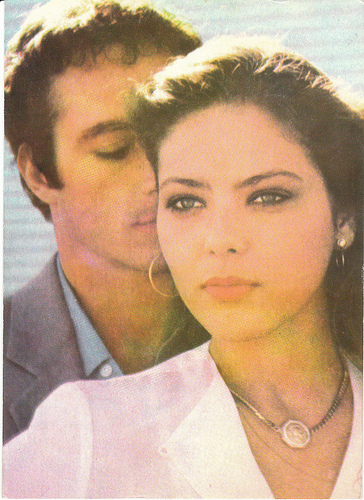
Romanian postcard by Acin. Source: Veronique@Flickr.
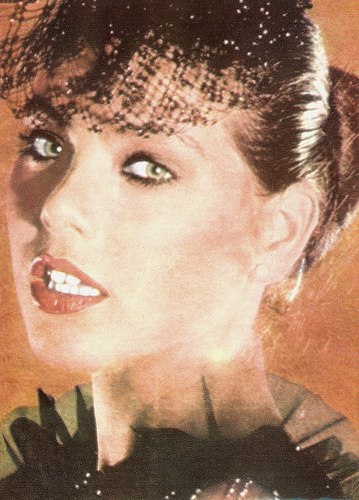
Romanian postcard by Casa Filmului Acin, no. c-da 43 139.

Romanian postcard by Casa Filmului Acin.
Gorgeous But Deadly
Ornella Muti made her British film debut as Princess Aura in Flash Gordon (Mike Hodges, 1980), based on the classic space opera adventure comic strip by Alex Raymond. In the 1930s, this comic strip had been the basis for a more straight-faced adventure serial. In the new Dino De Laurentiis production Flash's story was mined for exaggerated, cartoon humor by screenwriter Lorenzo Semple Jr., who had been a central figure in the similarly campy 1960s Batman TV series. The sets are spectacular and the rock score by Queen is appropriately over-the-top.
Ornella Muti shines as the luscious princess of the planet Mongo who tries to lure the blonde hero (Sam J. Jones). IMDb reviewer colleran-2: “Ornella Muti is simply unbelievable as Ming's gorgeous but deadly daughter. Replying to Flash's query as to whether he can use the telepathy machine to contact Dale with a perfectly candid, ‘If I showed you how. But I'm not going to’.”
Back in Italy, she appeared with Adriano Celentano in the comedy Il bisbetico domato/The Taming of the Scoundrel (Franco Castellano, Giuseppe Moccia, 1980), and with Giancarlo Giannini in the Russian-Italian drama La vita è bella/Life is Beautiful (Grigori Chukhrai, 1981).
Then followed one of Muti’s greatest successes, Storie di ordinaria follia/Tales of Ordinary Madness (Marco Ferreri, 1981), an adaptation of Charles Bukowski's roman à clef Erections, Ejaculations, Exhibitions and General Tales of Ordinary Madness. Nathan Southern at AllMovie : “Ben Gazzara delivers a gutsy, four-barreled performance as skid-row poet and storyteller Charles Bukowski (rechristened Charles Serking onscreen) (...); he eventually falls for a prostitute (Muti) who can express her affection only via self-mutilation. Ferreri lets Bukowski's ribald humor flow throughout and exposes the dark erotic currents at the heart of the author's narratives.”
The film's success lead to the belated release of the Hollywood production Love and Money (James Toback, 1982) with Muti prominent on the poster. The film had already been completed in 1980, but was shelved. She co-starred in Un amour de Swann/Swann in Love (Volker Schlöndorf, 1984), an ambitious attempt to film a portion of Marcel Proust's epic novel Remembrance of Things Past with Jeremy Irons as Charles Swann.
Television fans could see her in the TV movie Casanova (Simon Langton, 1987) featuring Richard Chamberlain. That year she also starred in the Gabriel García Márquez adaptation Cronaca di una morte annunciate/Chronicle of a Death Foretold (Francesco Rosi, 1987) opposite Rupert Everett .
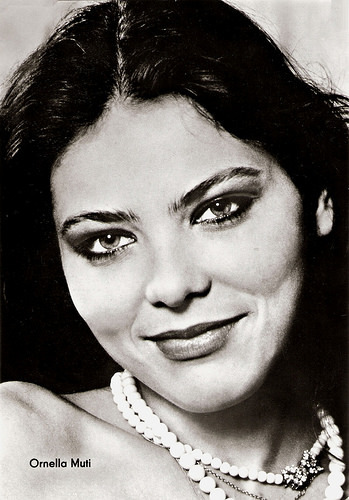
Big East-European postcard by VEB Progress Film-Verleih, Berlin, no. 8/82.
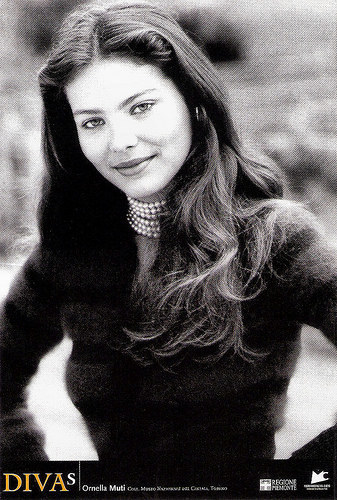
Italian postcard by Associazione Italiana Editori. Photo: Coll. Museo Nazionale del Cinema, Torino.
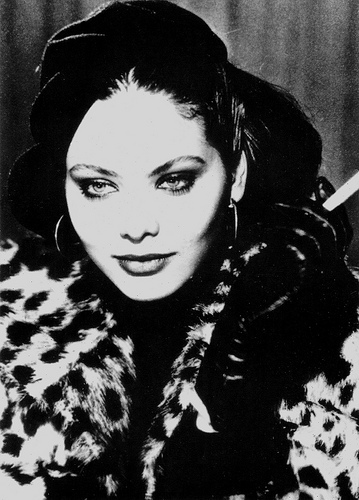
French postcard by Travelling Editions, Paris, no. CP 190.
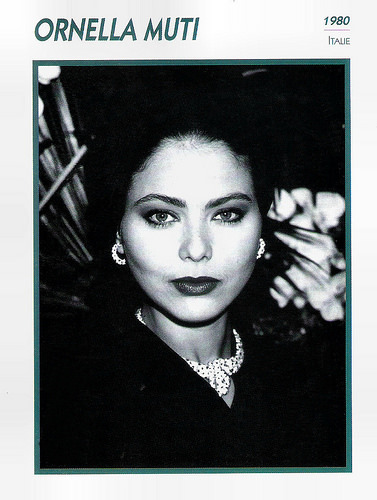
French collectors card in the series 'Portrait de Stars; L'encyclopédie du Cinéma' by Edito Service, 1991. Photo: SIPA. Caption: Ornella Muti, 1980, Italie.
Her Own Line of Jewellery
One of Ornella Muti’s most beautiful films is Wait Until Spring Bandini (Dominique Deruddere, 1990), based on a novel by John Fante and produced by Francis Coppola’s Zoetrope production. This smallscale film follows the trials of the Bandini family as they try to struggle through hard times in 1920s Colorado. Muti plays the anxious mother, wife of Joe Mantegna.
Her other English language films include the Sylvester Stallone comedy Oscar (John Landis, 1991) and another comedy flop Once Upon a Crime (Eugene Levy, 1992) with John Candy. In Italy, she appeared in the historical comedy Il viaggio di Capitan Fracassa/Captain Fracassa's Journey (Ettore Scola, 1990) with Vincent Perez, and loads of forgettable films.
In France she fared better and appeared in the thriller L'Inconnu de Strasbourg/The Unknown of Strasbourg (Valeria Sarmiento, 1998), director Lucas Belvaux's trilogy: Cavale/Trilogy: One (2002) - Un couple épatant/Trilogy: Two (2002) - Après la vie/Trilogy: Three (2002), and the comedy Les Bronzes 3: Amis Pour La Vie/Les Bronzes 3: Friends Forever (Patrice Leconte, 2006), but Ornella Muti is probably best known for a TV commercial of Giovanni Panzani pasta.
Ornella Muti has been married twice, to Alessio Orano, her fellow actor in La moglie più bella/The Most Beautiful Wife (1975–1981), and Federico Facchinetti (1988–1996). Muti has three children. She has a daughter by Spanish film producer José Luis Bermúdez de Castro, Naike Rivelli (1974). Naike is also a model and actress and has a close resemblance to her mother. Muti has also a son, actor Andrea Facchinetti, and a second daughter, Carolina Facchinetti, both from her second marriage. In 1996 her first grandchild Akash was born, a son of Naike. A second grandson named Alessandro followed from Carolina. From 1998 till 2008, Muti lived with Stefano Piccolo, a plastic surgeon. Since 2008, her partner has been Fabrice Kerhervé.
In 2008, Ornella Muti introduced her own line of jewellery. She opened new shops in Paris, Milan, Rome, Riga, Moscow and Almaty. She is also still active in the cinema. She appeared in Peter Greenaway’s The Tulse Luper Suitcases, Part 3: From Sark to the Finish (2003) with Roger Rees, The Tulse Luper Suitcases, Part 2: Vaux to the Sea (2004), and Peopling the Palaces at Venaria Reale (2007). She co-starred with Western icon Terence Hill and Paul Sorvinoin the Spaghetti Western Doc West/Triggerman (Terence Hill, Giulio Base, 2008) and was part of the ensemble cast of Woody Allen's mediocre romantic comedy To Rome with Love (Woody Allen, 2012).
In 2015, an Italian court sentenced Muti to eight months in prison or pay a fine of 30,000 euros for faking a medical certificate and skipping a play in which she was performing in 2010, to have dinner with Russian Prime Minister Vladimir Putin and several celebrities at a charity event held in St Petersburg, Russia.
Trailer for La moglie più bella/The Most Beautiful Wife (1970). Source: Danios12345 (YouTube).
Trailer for Flash Gordon (1980). Source: PickOfTheFlicks Tony (YouTube).
Compilation of scenes from Storie di ordinaria follia/Tales of Ordinary Madness (1981). Source: Gianfranco Firriolo (YouTube).
Trailer for Wait Until Spring Bandini (1990). Source: Ximon NL (YouTube).
Sources: AllMovie, MyMovies.It (Italian), Wikipedia, and .

Romanian postcard by Casa Filmului Acin.

French postcard, 1982, sent by mail in 1985. Photo: Angelo Frontoni.

French postcard by Humour a a la Carte, Paris, no. ST-150.

French postcard in the series Collection Cinéma Couleur by Editions La Malibran, Paris / Nancy, no. MC 34. Photo: Georges Pierre. Publicity still for Un amour de Swann/Swann in Love (Volker Schlöndorff, 1983).
The Best Filled Thing From Italy Since Ravioli
Ornella Muti was born in Rome in 1955 as Francesca Romana Rivelli, to a Neapolitan father, a journalist, and an Estonian mother, a sculptor. She has an older sister, Claudia Rivera, who was a soap actress in the 1970s.
As a teenager, the beauty with the cat-like blue eyes modelled and posed for illustrated novels. At 15, she made her film debut in the romantic melodrama La moglie più bella/The Most Beautiful Wife (Damiano Damiani, 1970).
In the following years she starred in such Giallos (Italian erotic thrillers) as Un posto ideale per uccidere/Oasis of Fear (Umberto Lenzi, 1971) with Irene Papas , and erotic dramas as Appasionata/Passionate (Gian Luigi Calderone, 1974) with Valentina Cortese . In Romanzo popolare/Come Home and Meet My Wife (Mario Monicelli, 1974) she married her 33-year older godfather ( Ugo Tognazi ).
Her international breakthrough was as the girlfriend of Gérard Depardieu in Marco Ferreri’s shocking psychological drama La dernière femme/The Last Woman (Marco Ferreri, 1976) about a man who mutilates himself drastically when the custody of his nine-month old son is threatened.
The role lead to more interesting films with well known directors including La Stanza Del Vescovo/The Bishop's Bedroom (Dino Risi, 1977) opposite Ugo Tognazi , Ritratto di Borghesia in Nero/Nest of Vipers (Tonino Cervi, 1977) with Senta Berger , and in France, Muti starred with Alain Delon in the crime thriller Mort d'un Pourri/Death of a Corrupt Man (George Lautner, 1977).
I Nuovi Mostri/Viva Italia (Mario Monicelli, Dino Risi, Ettore Scola, 1979) with Vittorio Gassman, was a black comedy, comprised of nine short stories all related to the theme that most men are selfish cads. The film was nominated for the Oscar for Best Foreign film. In America the film was promoted by a poster with Muti in swimsuit and a critic’s quote: “Ornella Muti is the best filled thing from Italy since ravioli”.

Romanian postcard by Casa Filmului Acin.

Romanian postcard by Acin. Source: Veronique@Flickr.

Romanian postcard by Casa Filmului Acin, no. c-da 43 139.

Romanian postcard by Casa Filmului Acin.
Gorgeous But Deadly
Ornella Muti made her British film debut as Princess Aura in Flash Gordon (Mike Hodges, 1980), based on the classic space opera adventure comic strip by Alex Raymond. In the 1930s, this comic strip had been the basis for a more straight-faced adventure serial. In the new Dino De Laurentiis production Flash's story was mined for exaggerated, cartoon humor by screenwriter Lorenzo Semple Jr., who had been a central figure in the similarly campy 1960s Batman TV series. The sets are spectacular and the rock score by Queen is appropriately over-the-top.
Ornella Muti shines as the luscious princess of the planet Mongo who tries to lure the blonde hero (Sam J. Jones). IMDb reviewer colleran-2: “Ornella Muti is simply unbelievable as Ming's gorgeous but deadly daughter. Replying to Flash's query as to whether he can use the telepathy machine to contact Dale with a perfectly candid, ‘If I showed you how. But I'm not going to’.”
Back in Italy, she appeared with Adriano Celentano in the comedy Il bisbetico domato/The Taming of the Scoundrel (Franco Castellano, Giuseppe Moccia, 1980), and with Giancarlo Giannini in the Russian-Italian drama La vita è bella/Life is Beautiful (Grigori Chukhrai, 1981).
Then followed one of Muti’s greatest successes, Storie di ordinaria follia/Tales of Ordinary Madness (Marco Ferreri, 1981), an adaptation of Charles Bukowski's roman à clef Erections, Ejaculations, Exhibitions and General Tales of Ordinary Madness. Nathan Southern at AllMovie : “Ben Gazzara delivers a gutsy, four-barreled performance as skid-row poet and storyteller Charles Bukowski (rechristened Charles Serking onscreen) (...); he eventually falls for a prostitute (Muti) who can express her affection only via self-mutilation. Ferreri lets Bukowski's ribald humor flow throughout and exposes the dark erotic currents at the heart of the author's narratives.”
The film's success lead to the belated release of the Hollywood production Love and Money (James Toback, 1982) with Muti prominent on the poster. The film had already been completed in 1980, but was shelved. She co-starred in Un amour de Swann/Swann in Love (Volker Schlöndorf, 1984), an ambitious attempt to film a portion of Marcel Proust's epic novel Remembrance of Things Past with Jeremy Irons as Charles Swann.
Television fans could see her in the TV movie Casanova (Simon Langton, 1987) featuring Richard Chamberlain. That year she also starred in the Gabriel García Márquez adaptation Cronaca di una morte annunciate/Chronicle of a Death Foretold (Francesco Rosi, 1987) opposite Rupert Everett .

Big East-European postcard by VEB Progress Film-Verleih, Berlin, no. 8/82.

Italian postcard by Associazione Italiana Editori. Photo: Coll. Museo Nazionale del Cinema, Torino.

French postcard by Travelling Editions, Paris, no. CP 190.

French collectors card in the series 'Portrait de Stars; L'encyclopédie du Cinéma' by Edito Service, 1991. Photo: SIPA. Caption: Ornella Muti, 1980, Italie.
Her Own Line of Jewellery
One of Ornella Muti’s most beautiful films is Wait Until Spring Bandini (Dominique Deruddere, 1990), based on a novel by John Fante and produced by Francis Coppola’s Zoetrope production. This smallscale film follows the trials of the Bandini family as they try to struggle through hard times in 1920s Colorado. Muti plays the anxious mother, wife of Joe Mantegna.
Her other English language films include the Sylvester Stallone comedy Oscar (John Landis, 1991) and another comedy flop Once Upon a Crime (Eugene Levy, 1992) with John Candy. In Italy, she appeared in the historical comedy Il viaggio di Capitan Fracassa/Captain Fracassa's Journey (Ettore Scola, 1990) with Vincent Perez, and loads of forgettable films.
In France she fared better and appeared in the thriller L'Inconnu de Strasbourg/The Unknown of Strasbourg (Valeria Sarmiento, 1998), director Lucas Belvaux's trilogy: Cavale/Trilogy: One (2002) - Un couple épatant/Trilogy: Two (2002) - Après la vie/Trilogy: Three (2002), and the comedy Les Bronzes 3: Amis Pour La Vie/Les Bronzes 3: Friends Forever (Patrice Leconte, 2006), but Ornella Muti is probably best known for a TV commercial of Giovanni Panzani pasta.
Ornella Muti has been married twice, to Alessio Orano, her fellow actor in La moglie più bella/The Most Beautiful Wife (1975–1981), and Federico Facchinetti (1988–1996). Muti has three children. She has a daughter by Spanish film producer José Luis Bermúdez de Castro, Naike Rivelli (1974). Naike is also a model and actress and has a close resemblance to her mother. Muti has also a son, actor Andrea Facchinetti, and a second daughter, Carolina Facchinetti, both from her second marriage. In 1996 her first grandchild Akash was born, a son of Naike. A second grandson named Alessandro followed from Carolina. From 1998 till 2008, Muti lived with Stefano Piccolo, a plastic surgeon. Since 2008, her partner has been Fabrice Kerhervé.
In 2008, Ornella Muti introduced her own line of jewellery. She opened new shops in Paris, Milan, Rome, Riga, Moscow and Almaty. She is also still active in the cinema. She appeared in Peter Greenaway’s The Tulse Luper Suitcases, Part 3: From Sark to the Finish (2003) with Roger Rees, The Tulse Luper Suitcases, Part 2: Vaux to the Sea (2004), and Peopling the Palaces at Venaria Reale (2007). She co-starred with Western icon Terence Hill and Paul Sorvinoin the Spaghetti Western Doc West/Triggerman (Terence Hill, Giulio Base, 2008) and was part of the ensemble cast of Woody Allen's mediocre romantic comedy To Rome with Love (Woody Allen, 2012).
In 2015, an Italian court sentenced Muti to eight months in prison or pay a fine of 30,000 euros for faking a medical certificate and skipping a play in which she was performing in 2010, to have dinner with Russian Prime Minister Vladimir Putin and several celebrities at a charity event held in St Petersburg, Russia.
Trailer for La moglie più bella/The Most Beautiful Wife (1970). Source: Danios12345 (YouTube).
Trailer for Flash Gordon (1980). Source: PickOfTheFlicks Tony (YouTube).
Compilation of scenes from Storie di ordinaria follia/Tales of Ordinary Madness (1981). Source: Gianfranco Firriolo (YouTube).
Trailer for Wait Until Spring Bandini (1990). Source: Ximon NL (YouTube).
Sources: AllMovie, MyMovies.It (Italian), Wikipedia, and .
Published on September 07, 2016 22:00
September 6, 2016
Berg-Ejvind och hans hustru (1918)
Today, EFSP presents another film special on a classic of the silent Scandinavian cinema. Berg-Ejvind och hans hustru/The Outlaw and His Wife (1918) is again directed by the Swedish maestro Victor Sjöström. The director himself plays the leading role in a harrowing adventure, situated in 18th century Iceland, when outlaw bandits roamed the mountains.
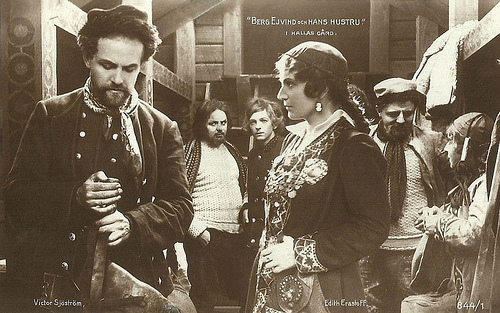
Swedish postcard by Nordisk Konst, Stockholm, no. 844/1. Photo: Svenska Biografteatern AB. Publicity still for Berg-Ejvind och hans hustru/The Outlaw and His Wife (Victor Sjöström, 1918) with Victor Sjöström and Edith Erastoff. Caption: At Halla's farm.
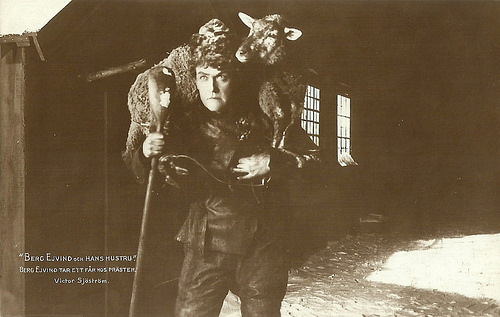
Swedish postcard by Nordisk Konst, Stockholm, no. 844/2. Photo: Svenska Biografteatern AB. Publicity still for Berg-Ejvind och hans hustru/The Outlaw and His Wife (Victor Sjöström, 1918) with Victor Sjöström . Caption: Berg-Ejvind steals a sheep from the priest.
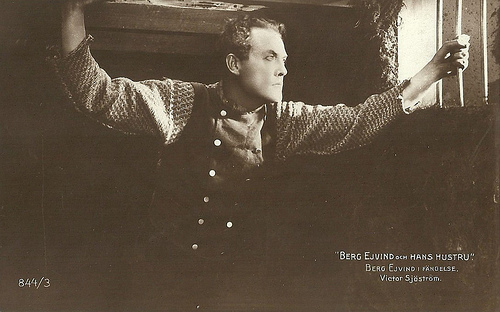
Swedish postcard by Nordisk Konst, Stockholm, no. 844/3. Photo: Svenska Biografteatern AB. Publicity still for Berg-Ejvind och hans hustru/The Outlaw and His Wife (Victor Sjöström, 1918) with Victor Sjöström . Caption: Berg-Ejvind in prison.
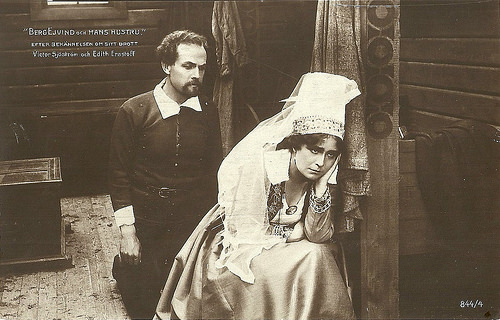
Swedish postcard by Nordisk Konst, Stockholm, no. 844/3. Photo: Svenska Biografteatern AB. Publicity still for Berg-Ejvind och hans hustru/The Outlaw and His Wife (Victor Sjöström, 1918) with Victor Sjöström and Edith Erastoff. Caption: After the confession of the crime.
Freezing together to death
Berg-Ejvind och hans hustru/The Outlaw and His Wife takes place in Iceland in mid-18th century. The outlaw Arnes (John Ekman) helps a stranger called Kari ( Victor Sjöström ) to start to work at the farm of widow Halla (Edith Erastoff).
Halla's brother-in-law Björn (Nils Aréhn) wants to marry her for economic purposes, but she refuses him. Instead Halla and the stranger fall in love. When he is revealed as Berg-Eyvind, an escaped thief forced into crime by his family's starvation (he stole a sheep from a priest who refused to help him), Halla abandons all and they flee. Berg-Eyvind and Halla become two of the many outlaws of Iceland's mountains.
For five years they lead a happy life and have a daughter Tota, but then Ejvind's old friend Arnes shows up, who first is hosted by the family but then starts to desire Halla. A fight between the men follows and Arnes leaves, meeting Björn and his men who have discovered the tracks of Halla and Berg-Ejvind.
During a fierce fight Halla is so afraid her child will be taken away that she throws it off a cliff. The couple manages to flee and retreat into the highest mountains. Over the years the situation becomes precarious. Halla is so overcome with guilt and longing for death she walks into a snowstorm. Eyvind finds the hut empty, goes out and finds her more death than alive and decides to freeze to death together with her.
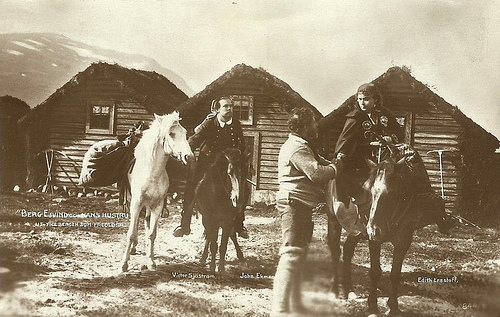
Swedish postcard by Nordisk Konst, Stockholm, no. 844/5. Photo: Svenska Biografteatern AB. Publicity still for Berg-Ejvind och hans hustru/The Outlaw and His Wife (Victor Sjöström, 1918) with Edith Erastoff, John Ekman and Victor Sjöström . Caption: Out into to the hills as outlaws.
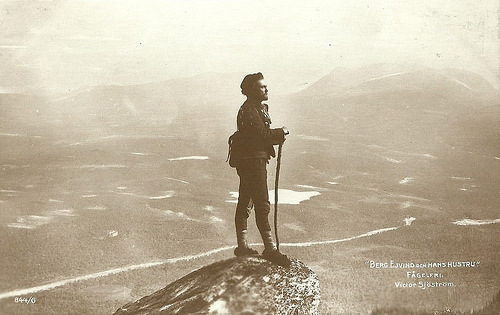
Swedish postcard by Nordisk Konst, Stockholm, no. 844/6. Photo: Svenska Biografteatern AB. Publicity still for Berg-Ejvind och hans hustru/The Outlaw and His Wife (Victor Sjöström, 1918) with Victor Sjöström . Caption: The Outlaw.

Swedish postcard by Nordisk Konst, Stockholm, no. 844/7. Photo: Svenska Biografteatern AB. Publicity still for Berg-Ejvind och hans hustru/The Outlaw and His Wife (Victor Sjöström, 1918) with Edith Erastoff, Nils Aréhn and Victor Sjöström . Caption: The battle between the parish bailiff and the outlaw.
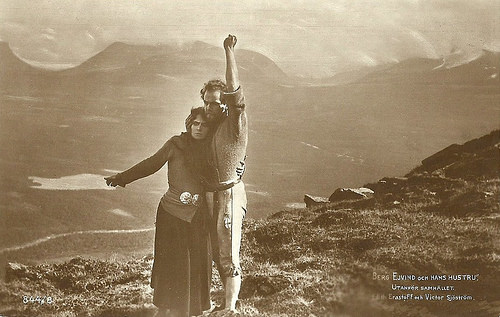
Swedish postcard by Nordisk Konst, Stockholm, no. 844/8. Photo: Svenska Biografteatern AB. Publicity still for Berg-Ejvind och hans hustru/The Outlaw and His Wife (Victor Sjöström, 1918) with Victor Sjöström and Edith Erastoff. Caption: Outside society.
The most beautiful film Louis Deluc saw until then
Berg-Ejvind och hans hustru/The Outlaw and His Wife is based on Fjalla-Eyvind (1911), a play by the Icelandic playwright Jóhann Sigurjónsson. The film is one of the classics of Swedish silent cinema.
Although Berg-Ejvind och hans hustru/The Outlaw and His Wife is set in Iceland, it was actually filmed in the North of Sweden, at Åre and Abisko. It showed not only a realist vision of the hardship of nature but also of the intolerance of humans.
Shot in 1917, Berg-Ejvind och hans hustru/The Outlaw and His Wife was released in 1918 in Sweden. Abroad it was released later. e.g. in Germany in 1922. When the film premiered, both Victor Sjöström 's direction and the the cinematography by Julius Jaenzon was praised.
French critic Louis Deluc called it the most beautiful film he saw until then, praising the director, the two leading actors and the landscape as the 'third protagonist'. Later critics like Georges Sadoul and Peter Cowie would confirm this. Cowie compared Berg-Eyvind to the knight in Ingmar Bergman's Det sjunde inseglet/The Seventh Seal (1957), both refusing to succumb to their fate until the very end. In a scene in which he is dangling on a rope above a cliff and saved just in time (a scene in which Sjöström truly risked his life), Berg-Eyvind shows he is a survivor, Cowie writes.
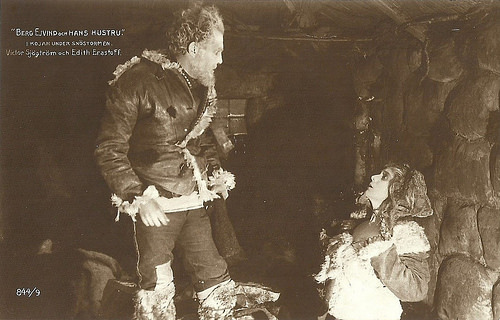
Swedish postcard by Nordisk Konst, Stockholm, no. 844/9. Photo: Svenska Biografteatern AB. Publicity still for Berg-Ejvind och hans hustru/The Outlaw and His Wife (Victor Sjöström, 1918) with Victor Sjöström and Edith Erastoff. Caption: In the hut during the snowstorm.
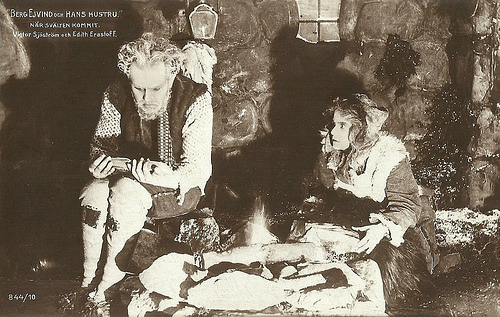
Swedish postcard by Nordisk Konst, Stockholm, no. 844/10. Photo: Svenska Biografteatern AB. Publicity still for Berg-Ejvind och hans hustru/The Outlaw and His Wife (Victor Sjöström, 1918) with Victor Sjöström and Edith Erastoff. Caption: When hunger comes.
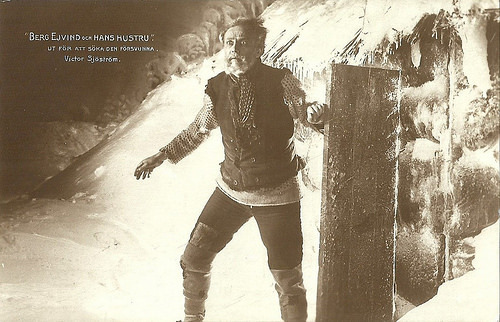
Swedish postcard by Nordisk Konst, Stockholm, no. 844/11. Photo: Svenska Biografteatern AB. Publicity still for Berg-Ejvind och hans hustru/The Outlaw and His Wife (Victor Sjöström, 1918) with Victor Sjöström . Caption: Out to seek the lost.
Sources: Wikipedia (English, Swedish, German and French) and IMDb.

Swedish postcard by Nordisk Konst, Stockholm, no. 844/1. Photo: Svenska Biografteatern AB. Publicity still for Berg-Ejvind och hans hustru/The Outlaw and His Wife (Victor Sjöström, 1918) with Victor Sjöström and Edith Erastoff. Caption: At Halla's farm.

Swedish postcard by Nordisk Konst, Stockholm, no. 844/2. Photo: Svenska Biografteatern AB. Publicity still for Berg-Ejvind och hans hustru/The Outlaw and His Wife (Victor Sjöström, 1918) with Victor Sjöström . Caption: Berg-Ejvind steals a sheep from the priest.

Swedish postcard by Nordisk Konst, Stockholm, no. 844/3. Photo: Svenska Biografteatern AB. Publicity still for Berg-Ejvind och hans hustru/The Outlaw and His Wife (Victor Sjöström, 1918) with Victor Sjöström . Caption: Berg-Ejvind in prison.

Swedish postcard by Nordisk Konst, Stockholm, no. 844/3. Photo: Svenska Biografteatern AB. Publicity still for Berg-Ejvind och hans hustru/The Outlaw and His Wife (Victor Sjöström, 1918) with Victor Sjöström and Edith Erastoff. Caption: After the confession of the crime.
Freezing together to death
Berg-Ejvind och hans hustru/The Outlaw and His Wife takes place in Iceland in mid-18th century. The outlaw Arnes (John Ekman) helps a stranger called Kari ( Victor Sjöström ) to start to work at the farm of widow Halla (Edith Erastoff).
Halla's brother-in-law Björn (Nils Aréhn) wants to marry her for economic purposes, but she refuses him. Instead Halla and the stranger fall in love. When he is revealed as Berg-Eyvind, an escaped thief forced into crime by his family's starvation (he stole a sheep from a priest who refused to help him), Halla abandons all and they flee. Berg-Eyvind and Halla become two of the many outlaws of Iceland's mountains.
For five years they lead a happy life and have a daughter Tota, but then Ejvind's old friend Arnes shows up, who first is hosted by the family but then starts to desire Halla. A fight between the men follows and Arnes leaves, meeting Björn and his men who have discovered the tracks of Halla and Berg-Ejvind.
During a fierce fight Halla is so afraid her child will be taken away that she throws it off a cliff. The couple manages to flee and retreat into the highest mountains. Over the years the situation becomes precarious. Halla is so overcome with guilt and longing for death she walks into a snowstorm. Eyvind finds the hut empty, goes out and finds her more death than alive and decides to freeze to death together with her.

Swedish postcard by Nordisk Konst, Stockholm, no. 844/5. Photo: Svenska Biografteatern AB. Publicity still for Berg-Ejvind och hans hustru/The Outlaw and His Wife (Victor Sjöström, 1918) with Edith Erastoff, John Ekman and Victor Sjöström . Caption: Out into to the hills as outlaws.

Swedish postcard by Nordisk Konst, Stockholm, no. 844/6. Photo: Svenska Biografteatern AB. Publicity still for Berg-Ejvind och hans hustru/The Outlaw and His Wife (Victor Sjöström, 1918) with Victor Sjöström . Caption: The Outlaw.

Swedish postcard by Nordisk Konst, Stockholm, no. 844/7. Photo: Svenska Biografteatern AB. Publicity still for Berg-Ejvind och hans hustru/The Outlaw and His Wife (Victor Sjöström, 1918) with Edith Erastoff, Nils Aréhn and Victor Sjöström . Caption: The battle between the parish bailiff and the outlaw.

Swedish postcard by Nordisk Konst, Stockholm, no. 844/8. Photo: Svenska Biografteatern AB. Publicity still for Berg-Ejvind och hans hustru/The Outlaw and His Wife (Victor Sjöström, 1918) with Victor Sjöström and Edith Erastoff. Caption: Outside society.
The most beautiful film Louis Deluc saw until then
Berg-Ejvind och hans hustru/The Outlaw and His Wife is based on Fjalla-Eyvind (1911), a play by the Icelandic playwright Jóhann Sigurjónsson. The film is one of the classics of Swedish silent cinema.
Although Berg-Ejvind och hans hustru/The Outlaw and His Wife is set in Iceland, it was actually filmed in the North of Sweden, at Åre and Abisko. It showed not only a realist vision of the hardship of nature but also of the intolerance of humans.
Shot in 1917, Berg-Ejvind och hans hustru/The Outlaw and His Wife was released in 1918 in Sweden. Abroad it was released later. e.g. in Germany in 1922. When the film premiered, both Victor Sjöström 's direction and the the cinematography by Julius Jaenzon was praised.
French critic Louis Deluc called it the most beautiful film he saw until then, praising the director, the two leading actors and the landscape as the 'third protagonist'. Later critics like Georges Sadoul and Peter Cowie would confirm this. Cowie compared Berg-Eyvind to the knight in Ingmar Bergman's Det sjunde inseglet/The Seventh Seal (1957), both refusing to succumb to their fate until the very end. In a scene in which he is dangling on a rope above a cliff and saved just in time (a scene in which Sjöström truly risked his life), Berg-Eyvind shows he is a survivor, Cowie writes.

Swedish postcard by Nordisk Konst, Stockholm, no. 844/9. Photo: Svenska Biografteatern AB. Publicity still for Berg-Ejvind och hans hustru/The Outlaw and His Wife (Victor Sjöström, 1918) with Victor Sjöström and Edith Erastoff. Caption: In the hut during the snowstorm.

Swedish postcard by Nordisk Konst, Stockholm, no. 844/10. Photo: Svenska Biografteatern AB. Publicity still for Berg-Ejvind och hans hustru/The Outlaw and His Wife (Victor Sjöström, 1918) with Victor Sjöström and Edith Erastoff. Caption: When hunger comes.

Swedish postcard by Nordisk Konst, Stockholm, no. 844/11. Photo: Svenska Biografteatern AB. Publicity still for Berg-Ejvind och hans hustru/The Outlaw and His Wife (Victor Sjöström, 1918) with Victor Sjöström . Caption: Out to seek the lost.
Sources: Wikipedia (English, Swedish, German and French) and IMDb.
Published on September 06, 2016 22:00
September 5, 2016
Mariella Lotti
Blonde Italian film actress Mariella Lotti (1921–2006) played leading ladies in a number of Fascist era and post-war films. The refined beauty quickly became one of the most popular Italian divas of the 1940s.
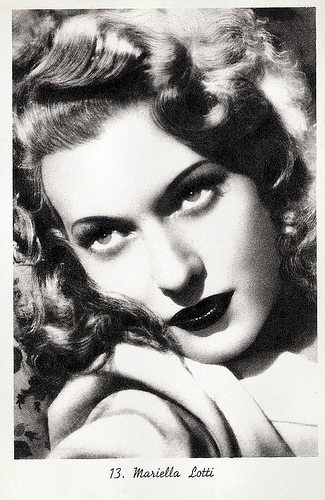
Italian postcard, no. 13.
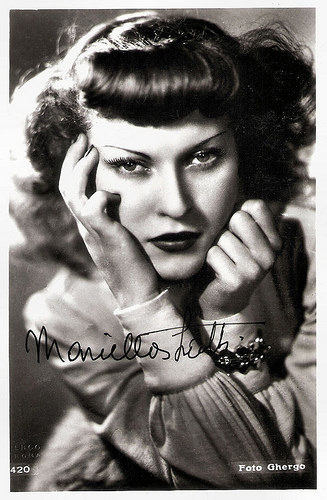
Italian postcard by A. Terzoli, Roma, no. 420. Photo: Ghergo.
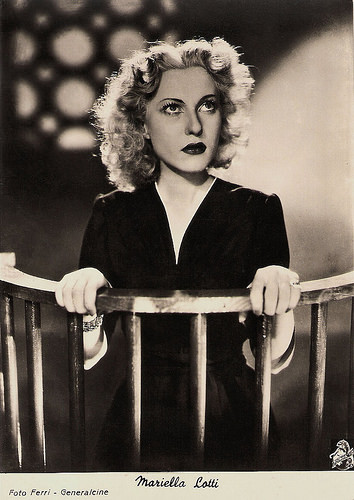
Italian postcard by Alterocca, Terni, no. 6619. Photo: Ferri / Generalcine. Publicity still for Il fiore sotto gli occhi/The flower under the eyes (Guido Brignone, 1944).
The Ten Commandments
Mariella Lotti was born Anna Maria Pianotti in 1921 in Busto Arsizio, Lombardy, Italy. Her sister Carola Lotti was also an actress.
In 1939, Mariella made her film debut with a small part in the comedy I figli del marchese Lucera/The sons of the Marquis Lucera (Amleto Palermi, 1939) with Armando Falconi . The following year, she played an important part in the adventure film La figlia del corsaro verde/The Daughter of the Green Pirate (Enrico Guazzoni, 1940), starring Doris Duranti , Fosco Giachetti and Camillo Pilotto .
She also played a supporting part in Il signore della tavern/The tavern ladies (Amleto Palermi, 1940). That year she also appeared in the dramas Kean (Guido Brignone, 1940) with Rossano Brazzi , and Il ponte dei sospiri/The Bridge of Sighs (Mario Bonnard, 1940) with Paola Barbara .
Two years later Lotti appeared in the drama Fari nella nebbia/Headlights in the Fog (Gianni Franciolini, 1942) starring Fosco Giachetti, Luisa Ferida and Antonio Centa . The film follows the lives of a group of truck drivers. It is considered to be part of the development of Neorealism, which emerged around this time.
Lotti then played the title role in the historical adventure film La Gorgona/The Gorgon (Guido Brignone, 1942) about the young daughter of a heroically killed nobleman in 11th Century Pisa who - as the figurehead virgin - will maintain a lantern to celebrate the men's victorious return after driving out the Saracens who are infesting the Mediterranean.
Other films of the fascist era include Quelli della montagna/Those of the Mountain (Aldo Vergano, 1943) with Amedeo Nazzari , the Opera film Silenzio, si gira!/Silence, film recording! (Carlo Campogalliani, 1943) starring Beniamino Gigli , and the war drama Squadriglia bianca (Ion Sava, 1944) with Claudio Gora.
Lotti was one of the many actors employed on the anthology film I dieci comandamenti/The Ten Commandments (Giorgio Walter Chili, 1946), made following the overthrow of Benito Mussolini. The film was shot in Rome in 1944-1945 during the Republic of Salò (when the country occupied by the Germans). At that time, all cinematic activity was transferred to Venice but many actors and technicians refused to go. This film was specifically produced to provide work for all those who decided to stay in Rome. All personnel for the film was able to obtain a work permit from the Vatican as the film, which was based on the classic Bible story, was produced by PROFIR, a Catholic production house closely linked with the catholic church. The film is now considered lost.
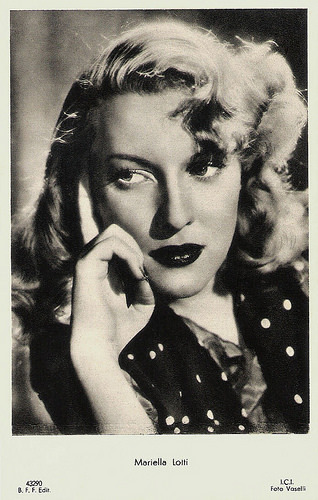
Italian postcard by B.F.F. Edit, no. 43290. Photo: I.C.I. / Vaselli. Publicity still for Fari nella nebbia/Headlights in the fog (Gianni Franciolini, 1942).
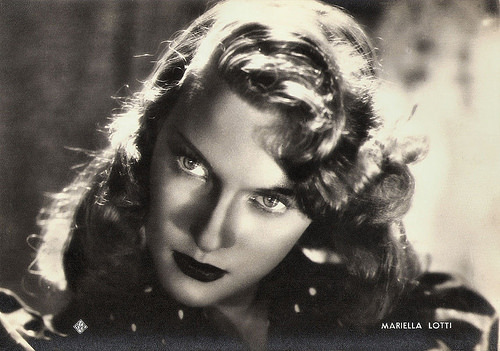
Italian postcard by A. Scarmiglia Ed., Roma (ASER), no. 122. Photo: Fauno Film / Vaselli. Publicity still for Fari nella nebbia/Headlights in the fog (Gianni Franciolini, 1941).
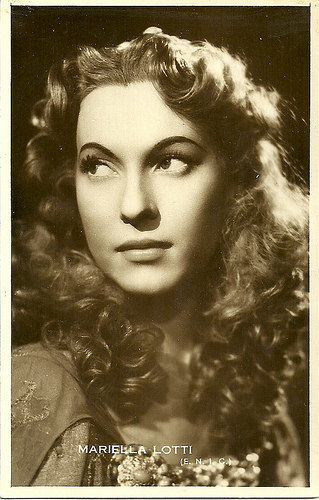
Italian postcard by ENIC.
Pink Neorealism
In 1946, Mariella Lotti played a nun in the Neorealist war film Un giorno nella vita/A Day in Life (Alessandro Blasetti, 1946), about a group of partisans seeking refuge in a cloistered convent. The film was entered into the 1946 Cannes Film Festival.
She also played the female lead opposite Otello Toso and Amedeo Nazzari in the drama Malacarne/For the Love of Mariastella (1946), written and directed by Pino Mercanti. Based on a story of the Sicilian writer Giuseppe Zucca, it was mainly shot in the tonnara (tuna fisher village) of Castellammare del Golfo, with some scenes shot in the tonnaras of Scopello and of San Vito Lo Capo. It is considered as a progenitor of Pink Neorealism, the lighter genre which followed Neorealism when Italy’s conditions approved.
Lotti then co-starred with Fosco Giachetti and Andrea Checchi in the drama I fratelli Karamazoff/The Brothers Karamazov (Giacomo Gentilomo, 1947), based on the novel with the same title by Fyodor Dostoyevsky. It won two Nastro d'Argento Awards, for best screenplay and for best score. She also starred in the historical drama Guarany (Riccardo Freda, 1948) with Antonio Vilar and Gianna Maria Canale , the Italian/American Swashbuckler I pirati di Capri/The Pirates of Capri (Edgar G. Ulmer, 1949) starring Louis Hayward, and opposite Jean Gabin in the drama È più facile che un cammello.../His Last Twelve Hours (Luigi Zampa, 1951).
In the following years her parts became smaller. She played a supporting part in the drama Processo alla città/The City Stands Trial (Luigi Zampa, 1952) with Amedeo Nazzari . The film is based on a revisiting of the Cuocolo murders and the struggle for control of Naples by the Camorra in the early 1900s. It is considered to be director Luigi Zampa's most accomplished film and was entered into the 3rd Berlin International Film Festival.
Her final film was the Spanish-Italian drama Carmen proibita/Siempre Carmen (Giuseppe Maria Scotese, 1953) featuring Ana Esmeralda. She also acted in the theatre and worked on two stage productions with Luchino Visconti. Mariella Lotti was married to the industrialist Alfredo Zanardo. Earlier she had a well publicised affair with Michel, Prince of Romania. There is little known about her later life, According to most sources, Mariella Lotti passed away in 2006 in Bologna, Italy, at the age of 84. In 2015, Pietro Trellini at The Blog did some research and discovered that Lotti moved to Brazil in the early 1950s and he suggests she is still alive.
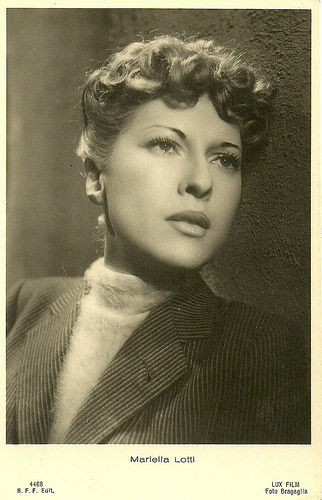
Italian postcard by Ballerini & Fratini Editori, Firenze, no. 4468. Photo: Bragalia / Lux Film.
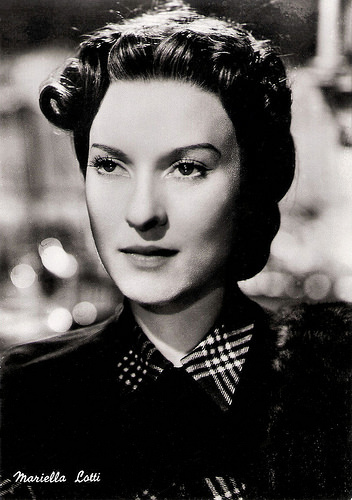
Italian postcard by Rotalfoto, Milano / Ediz. Garami, no. 143.
Sources: Piero Trellini (The Blog – Italian), Wikipedia (Italian and English) and .

Italian postcard, no. 13.

Italian postcard by A. Terzoli, Roma, no. 420. Photo: Ghergo.

Italian postcard by Alterocca, Terni, no. 6619. Photo: Ferri / Generalcine. Publicity still for Il fiore sotto gli occhi/The flower under the eyes (Guido Brignone, 1944).
The Ten Commandments
Mariella Lotti was born Anna Maria Pianotti in 1921 in Busto Arsizio, Lombardy, Italy. Her sister Carola Lotti was also an actress.
In 1939, Mariella made her film debut with a small part in the comedy I figli del marchese Lucera/The sons of the Marquis Lucera (Amleto Palermi, 1939) with Armando Falconi . The following year, she played an important part in the adventure film La figlia del corsaro verde/The Daughter of the Green Pirate (Enrico Guazzoni, 1940), starring Doris Duranti , Fosco Giachetti and Camillo Pilotto .
She also played a supporting part in Il signore della tavern/The tavern ladies (Amleto Palermi, 1940). That year she also appeared in the dramas Kean (Guido Brignone, 1940) with Rossano Brazzi , and Il ponte dei sospiri/The Bridge of Sighs (Mario Bonnard, 1940) with Paola Barbara .
Two years later Lotti appeared in the drama Fari nella nebbia/Headlights in the Fog (Gianni Franciolini, 1942) starring Fosco Giachetti, Luisa Ferida and Antonio Centa . The film follows the lives of a group of truck drivers. It is considered to be part of the development of Neorealism, which emerged around this time.
Lotti then played the title role in the historical adventure film La Gorgona/The Gorgon (Guido Brignone, 1942) about the young daughter of a heroically killed nobleman in 11th Century Pisa who - as the figurehead virgin - will maintain a lantern to celebrate the men's victorious return after driving out the Saracens who are infesting the Mediterranean.
Other films of the fascist era include Quelli della montagna/Those of the Mountain (Aldo Vergano, 1943) with Amedeo Nazzari , the Opera film Silenzio, si gira!/Silence, film recording! (Carlo Campogalliani, 1943) starring Beniamino Gigli , and the war drama Squadriglia bianca (Ion Sava, 1944) with Claudio Gora.
Lotti was one of the many actors employed on the anthology film I dieci comandamenti/The Ten Commandments (Giorgio Walter Chili, 1946), made following the overthrow of Benito Mussolini. The film was shot in Rome in 1944-1945 during the Republic of Salò (when the country occupied by the Germans). At that time, all cinematic activity was transferred to Venice but many actors and technicians refused to go. This film was specifically produced to provide work for all those who decided to stay in Rome. All personnel for the film was able to obtain a work permit from the Vatican as the film, which was based on the classic Bible story, was produced by PROFIR, a Catholic production house closely linked with the catholic church. The film is now considered lost.

Italian postcard by B.F.F. Edit, no. 43290. Photo: I.C.I. / Vaselli. Publicity still for Fari nella nebbia/Headlights in the fog (Gianni Franciolini, 1942).

Italian postcard by A. Scarmiglia Ed., Roma (ASER), no. 122. Photo: Fauno Film / Vaselli. Publicity still for Fari nella nebbia/Headlights in the fog (Gianni Franciolini, 1941).

Italian postcard by ENIC.
Pink Neorealism
In 1946, Mariella Lotti played a nun in the Neorealist war film Un giorno nella vita/A Day in Life (Alessandro Blasetti, 1946), about a group of partisans seeking refuge in a cloistered convent. The film was entered into the 1946 Cannes Film Festival.
She also played the female lead opposite Otello Toso and Amedeo Nazzari in the drama Malacarne/For the Love of Mariastella (1946), written and directed by Pino Mercanti. Based on a story of the Sicilian writer Giuseppe Zucca, it was mainly shot in the tonnara (tuna fisher village) of Castellammare del Golfo, with some scenes shot in the tonnaras of Scopello and of San Vito Lo Capo. It is considered as a progenitor of Pink Neorealism, the lighter genre which followed Neorealism when Italy’s conditions approved.
Lotti then co-starred with Fosco Giachetti and Andrea Checchi in the drama I fratelli Karamazoff/The Brothers Karamazov (Giacomo Gentilomo, 1947), based on the novel with the same title by Fyodor Dostoyevsky. It won two Nastro d'Argento Awards, for best screenplay and for best score. She also starred in the historical drama Guarany (Riccardo Freda, 1948) with Antonio Vilar and Gianna Maria Canale , the Italian/American Swashbuckler I pirati di Capri/The Pirates of Capri (Edgar G. Ulmer, 1949) starring Louis Hayward, and opposite Jean Gabin in the drama È più facile che un cammello.../His Last Twelve Hours (Luigi Zampa, 1951).
In the following years her parts became smaller. She played a supporting part in the drama Processo alla città/The City Stands Trial (Luigi Zampa, 1952) with Amedeo Nazzari . The film is based on a revisiting of the Cuocolo murders and the struggle for control of Naples by the Camorra in the early 1900s. It is considered to be director Luigi Zampa's most accomplished film and was entered into the 3rd Berlin International Film Festival.
Her final film was the Spanish-Italian drama Carmen proibita/Siempre Carmen (Giuseppe Maria Scotese, 1953) featuring Ana Esmeralda. She also acted in the theatre and worked on two stage productions with Luchino Visconti. Mariella Lotti was married to the industrialist Alfredo Zanardo. Earlier she had a well publicised affair with Michel, Prince of Romania. There is little known about her later life, According to most sources, Mariella Lotti passed away in 2006 in Bologna, Italy, at the age of 84. In 2015, Pietro Trellini at The Blog did some research and discovered that Lotti moved to Brazil in the early 1950s and he suggests she is still alive.

Italian postcard by Ballerini & Fratini Editori, Firenze, no. 4468. Photo: Bragalia / Lux Film.

Italian postcard by Rotalfoto, Milano / Ediz. Garami, no. 143.
Sources: Piero Trellini (The Blog – Italian), Wikipedia (Italian and English) and .
Published on September 05, 2016 22:00
September 4, 2016
Ulla Jacobsson
Swedish film and stage actress Ulla Jacobsson (1929-1982) achieved international fame with a nude scene in her second film, Hon dansade en sommar/One Summer of Happiness (1951). Another highlight was her serene performance in Bergman's Sommarnattens leende/Smiles of a Summer Night (1955).
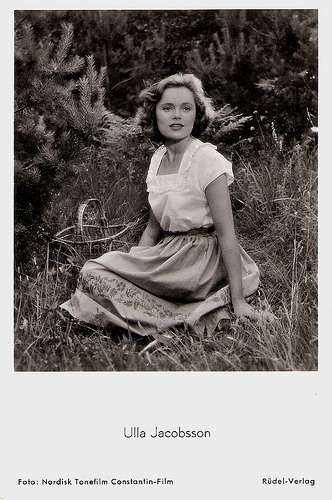
German postcard by Rüdel-Verlag, Hamburg-Bergedorf, no. 548. Photo: Nordisk Tonefilm / Constantin-Film. Publicity still for Hon dansade en sommar/One Summer of Happiness (Arne Mattsson, 1951).
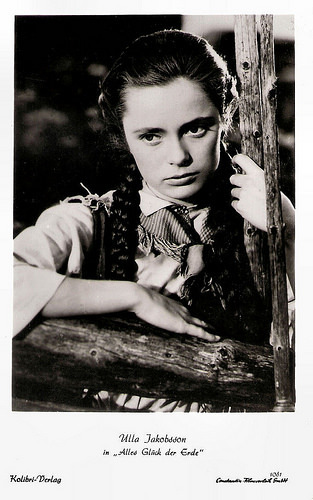
German postcard by Kolibri-Verlag, no. 1081. Photo: Constantin-Film-Verleih. Publicity still for All jordens fröjd/All the World's Delights (Rolf Husberg, 1953).

German postcard by Rüdel-Verlag, no. 1999. Photo: CCC / Constantin-Film / Grimm. Publicity still for Die Letzten werden die Ersten sein/The Last Ones Shall Be First (Rolf Hansen, 1957).
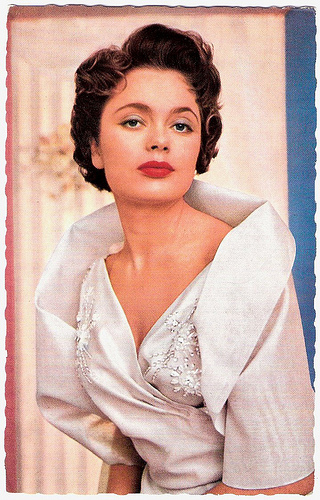
German postcard by Kolbri-Verlag, Minden/Westf., no. F 10. Retail price: 25 Pf. Photo: Constantin/Leonard. Publicity still for Die Letzten werden die Ersten sein/The Last Ones Shall Be First (Rolf Hansen, 1957).

German postcard by Universum-film Aktiengesellschaft (UFA), Berlin-Templehof, no. CK-247. Retail price: 30 Pfg. Photo: Klaus Collignon.
Sensation
Ulla Jacobsson was born in 1929 in Mölndal, a part of the Göteborg (Gothenburg) urban area on the west-coast of Sweden. After her stage debut in Göteborg’s Stadsteater in 1947, she appeared in plays by Kaj Munk, Bertolt Brecht, Jean Anouilh, and William Shakespeare.
She made her first film appearance in Bärande hav/The seas we travel (Arne Mattsson, 1951) with Alf Kjellin. Her second film with the same director, Hon dansade en sommar/One Summer of Happiness (Arne Mattsson, 1951), was presented at the Cannes Film Festival in 1951.
Based on the novel by Per Olof Ekstrom, the story revolves around the romance between 19-year old student Goran (Folke Sundquist) and the 17-year old farmer's daughter Kerstin (Ulla Jacobsson). A scene where Goran and Kerstin swim and embrace in the nude caused a sensation and made Jacobsson world-famous. In Cannes the film won a prize for the music and at the Berlin Film Festival the film was awarded with the Golden Bear.
Next Jacobsson appeared in such Swedish productions as All jordens fröjd/All the World's Delights (Rolf Husberg, 1953), the August Strindberg adaptation Karin Månsdotter (Alf Sjöberg, 1954), and Herr Arnes penningar/Sir Arne's Treasure (Gustaf Molander, 1954).
In Germany she also appeared in films, including Die Heilige Lüge/Pious Lies (Wolfgang Liebeneiner, 1954) with Karlheinz Böhm , and Der Pfarrer von Kirchfeld/The Priest from Kirchfeld (Hans Deppe, 1955) with Claus Holm .
Another international hit was the comedy of manners Sommarnattens leende/Smiles of a Summer Night (Ingmar Bergman, 1955). Bergman's comic masterpiece opens with middle-aged lawyer Frederik Egerman (Gunnar Bjornstrand) again failing to consummate his marriage with the much younger Anne (Ulla Jacobsson). At IMDb , reviewer Clavallie writes: “Charming, light-hearted, delicate, and romantic are not the terms most people think to use when describing Bergman films, and yet Smiles of a Summer Night is all of these. This is one of the most sophisticated romantic movies ever filmed, and a pure delight. It is a clever and witty romance based on the classic elements of French farce. Simply wonderful.”
The film’s success started Jacobsson’s international career. In France she starred in Crime et châtiment/Crime and punishment (Georges Lampin, 1956), an updated version of Fyodor Dostoyevsky's story about the Nietzchean student Raskolnikov ( Bernard Blier ). In Germany she appeared with O.E. Hasse and Maximilian Schell in Die Letzten werden die Ersten sein/The Last Ones Shall Be First (Rolf Hansen, 1957). That year she moved to Vienna, where she was offered an engagement at the Theater in der Josefstadt.
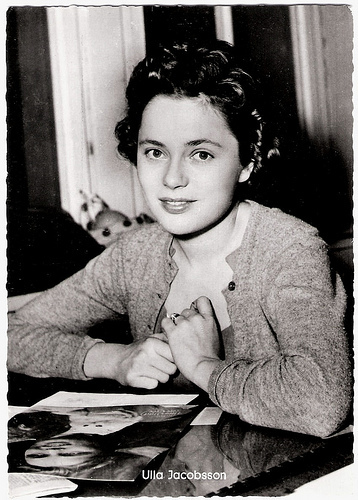
German postcard, no. 1048.
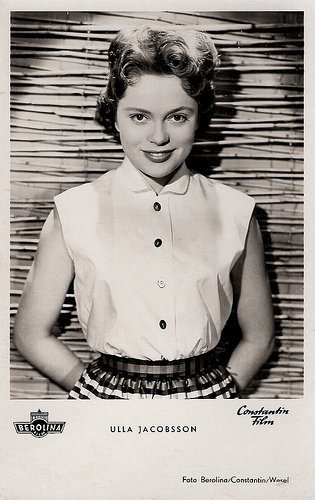
German postcard by Kunst und Bild, Berlin, no. A 1150. Photo: Berolina-Constantin-Wesel. Publicity photo for Und ewig bleibt die Liebe/Eternal Love (Wolfgang Liebeneiner, 1954).
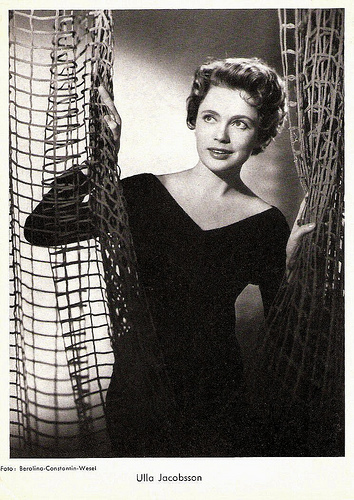
German collector's card. Photo: Berolina-Constantin-Wesel.
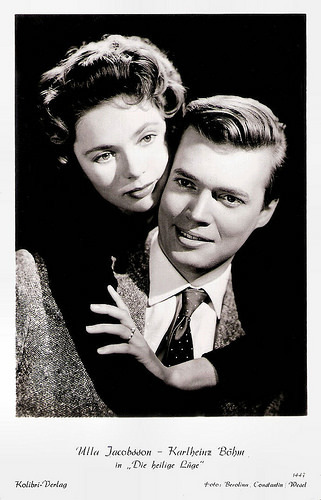
German postcard by Kolibri-Verlag, no. 1447. Photo: Berolina / Constantin-Film / Wesel. Publicity still for Die heilige Lüge/Saintly Lie (Wolfgang Liebeneiner, 1954) with Karlheinz Böhm .
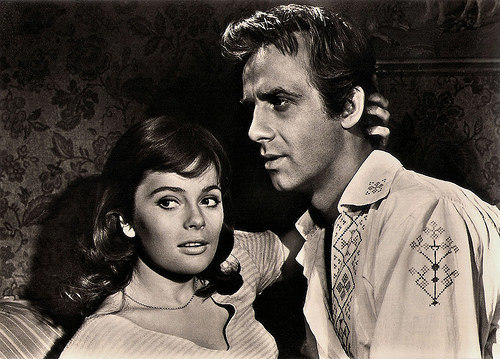
East-German postcard by VEB Progress Filmverlag, Berlin, no. 2.338, 1965. Photo: publicity still for Sången om den eldröda blomman/Song of the Scarlet Flower (Gustaf Molander, 1956) with Ulla Jacobsson and Jarl Kulle.
Swedish Sex Symbol
In the early 1960s, Ulla Jacobsson started appearing in English language films. She made one American film, the light romantic comedy Love Is a Ball (David Swift, 1963) starring Charles Boyer . At AllMovie , Hal Erickson writes: “the graceful and talented Jacobsson had to withstand an idiotic ad campaign which tried to redefine her as a Swedish ‘sex symbol’."
Normally she tended to play serious and anxious looking characters. In Great Britain she became better known for her part of the daughter of a missionary (played by Jack Hawkins) in Zulu (Cy Endfield, 1964). Filmed on a grand scale, Zulu is a rousing recreation of the 1879 siege of Rorke's Drift in Natal, Africa. An army of 4,000 Zulu warriors had already decimated a huge British garrison; and now threatened the much smaller Rorke's Drift with less than 100 British soldiers.
After this film, Jacobsson started hopscotching between Europe and England for the balance of her career. Other notable films include the war film The Heroes of Telemark (Anthony Mann, 1965) with Kirk Douglas, and La Servante/The Servant (Jacques-Paul Bertrand, 1970) with France Anglade. She won the Deutschen Filmpreis (German Film Award) for Supporting Actress for her part in Alle Jahre wieder/Next Year, Same Time (Ulrich Schamoni, 1967) with Sabine Sinjen .
She reunited with her first director, Arne Matsson for Bamse/My Father's Mistress (Arne Mattsson, 1970). Her last films were Wolfgang Petersen’s thriller Einer Von Uns Beiden/One or the Other (Wolfgang Petersen, 1975) with Elke Sommer , and Fassbinder’s Faustrecht der Freiheit/Fox and His Friends (Rainer Werner Fassbinder, 1975). The latter was the interesting and heartbreaking story of Fox, a gay sideshow worker (played by Fassbinder himself) who wins the lottery, only to be exploited to the hilt by his upper-class lover (Peter Chatel). Jacobsson played Chatel’s mother.
Later she only made a few more TV-films, including the miniseries Das Ding/The Thing (Uli Edel, 1978). The reason for her retirement was that she had fallen ill. In 1982 she died from bone cancer in a hospital in her hometown Vienna. She was 53.
Ulla Jacobsson was married three times. Her first marriage was to the Viennese engineer Josef Kornfeld, with whom she had a daughter, Ditte. Then she was married to Dutch painter Frank Lodeizen, with whom she had a son, Martin. Lodeizen’s daughter Rifka Lodeizen from a later marriage is now a well known film actress in the Netherlands. Jacobsson finally married Austrian ethnologist Hans Winfried Rohsmann.
American trailer for Hon dansade en sommar/One Summer of Happiness (1951). Source: Samuka Sam (YouTube).
Scene with Margit Carlqvist and Ulla Jacobsson in Sommarnattens leende/Smiles of a Summer Night (1955). Source: Prfit (YouTube).
Trailer for Zulu (1964). Source: 05HK09 (YouTube).
Trailer for The Heroes Of Telemark (1965). Source: Sala de Exibição (YouTube).
Sources: Hal Erickson (AllMovie), (IMDb), Wikipedia (English, French and Swedish) and .

German postcard by Rüdel-Verlag, Hamburg-Bergedorf, no. 548. Photo: Nordisk Tonefilm / Constantin-Film. Publicity still for Hon dansade en sommar/One Summer of Happiness (Arne Mattsson, 1951).

German postcard by Kolibri-Verlag, no. 1081. Photo: Constantin-Film-Verleih. Publicity still for All jordens fröjd/All the World's Delights (Rolf Husberg, 1953).

German postcard by Rüdel-Verlag, no. 1999. Photo: CCC / Constantin-Film / Grimm. Publicity still for Die Letzten werden die Ersten sein/The Last Ones Shall Be First (Rolf Hansen, 1957).

German postcard by Kolbri-Verlag, Minden/Westf., no. F 10. Retail price: 25 Pf. Photo: Constantin/Leonard. Publicity still for Die Letzten werden die Ersten sein/The Last Ones Shall Be First (Rolf Hansen, 1957).

German postcard by Universum-film Aktiengesellschaft (UFA), Berlin-Templehof, no. CK-247. Retail price: 30 Pfg. Photo: Klaus Collignon.
Sensation
Ulla Jacobsson was born in 1929 in Mölndal, a part of the Göteborg (Gothenburg) urban area on the west-coast of Sweden. After her stage debut in Göteborg’s Stadsteater in 1947, she appeared in plays by Kaj Munk, Bertolt Brecht, Jean Anouilh, and William Shakespeare.
She made her first film appearance in Bärande hav/The seas we travel (Arne Mattsson, 1951) with Alf Kjellin. Her second film with the same director, Hon dansade en sommar/One Summer of Happiness (Arne Mattsson, 1951), was presented at the Cannes Film Festival in 1951.
Based on the novel by Per Olof Ekstrom, the story revolves around the romance between 19-year old student Goran (Folke Sundquist) and the 17-year old farmer's daughter Kerstin (Ulla Jacobsson). A scene where Goran and Kerstin swim and embrace in the nude caused a sensation and made Jacobsson world-famous. In Cannes the film won a prize for the music and at the Berlin Film Festival the film was awarded with the Golden Bear.
Next Jacobsson appeared in such Swedish productions as All jordens fröjd/All the World's Delights (Rolf Husberg, 1953), the August Strindberg adaptation Karin Månsdotter (Alf Sjöberg, 1954), and Herr Arnes penningar/Sir Arne's Treasure (Gustaf Molander, 1954).
In Germany she also appeared in films, including Die Heilige Lüge/Pious Lies (Wolfgang Liebeneiner, 1954) with Karlheinz Böhm , and Der Pfarrer von Kirchfeld/The Priest from Kirchfeld (Hans Deppe, 1955) with Claus Holm .
Another international hit was the comedy of manners Sommarnattens leende/Smiles of a Summer Night (Ingmar Bergman, 1955). Bergman's comic masterpiece opens with middle-aged lawyer Frederik Egerman (Gunnar Bjornstrand) again failing to consummate his marriage with the much younger Anne (Ulla Jacobsson). At IMDb , reviewer Clavallie writes: “Charming, light-hearted, delicate, and romantic are not the terms most people think to use when describing Bergman films, and yet Smiles of a Summer Night is all of these. This is one of the most sophisticated romantic movies ever filmed, and a pure delight. It is a clever and witty romance based on the classic elements of French farce. Simply wonderful.”
The film’s success started Jacobsson’s international career. In France she starred in Crime et châtiment/Crime and punishment (Georges Lampin, 1956), an updated version of Fyodor Dostoyevsky's story about the Nietzchean student Raskolnikov ( Bernard Blier ). In Germany she appeared with O.E. Hasse and Maximilian Schell in Die Letzten werden die Ersten sein/The Last Ones Shall Be First (Rolf Hansen, 1957). That year she moved to Vienna, where she was offered an engagement at the Theater in der Josefstadt.

German postcard, no. 1048.

German postcard by Kunst und Bild, Berlin, no. A 1150. Photo: Berolina-Constantin-Wesel. Publicity photo for Und ewig bleibt die Liebe/Eternal Love (Wolfgang Liebeneiner, 1954).

German collector's card. Photo: Berolina-Constantin-Wesel.

German postcard by Kolibri-Verlag, no. 1447. Photo: Berolina / Constantin-Film / Wesel. Publicity still for Die heilige Lüge/Saintly Lie (Wolfgang Liebeneiner, 1954) with Karlheinz Böhm .

East-German postcard by VEB Progress Filmverlag, Berlin, no. 2.338, 1965. Photo: publicity still for Sången om den eldröda blomman/Song of the Scarlet Flower (Gustaf Molander, 1956) with Ulla Jacobsson and Jarl Kulle.
Swedish Sex Symbol
In the early 1960s, Ulla Jacobsson started appearing in English language films. She made one American film, the light romantic comedy Love Is a Ball (David Swift, 1963) starring Charles Boyer . At AllMovie , Hal Erickson writes: “the graceful and talented Jacobsson had to withstand an idiotic ad campaign which tried to redefine her as a Swedish ‘sex symbol’."
Normally she tended to play serious and anxious looking characters. In Great Britain she became better known for her part of the daughter of a missionary (played by Jack Hawkins) in Zulu (Cy Endfield, 1964). Filmed on a grand scale, Zulu is a rousing recreation of the 1879 siege of Rorke's Drift in Natal, Africa. An army of 4,000 Zulu warriors had already decimated a huge British garrison; and now threatened the much smaller Rorke's Drift with less than 100 British soldiers.
After this film, Jacobsson started hopscotching between Europe and England for the balance of her career. Other notable films include the war film The Heroes of Telemark (Anthony Mann, 1965) with Kirk Douglas, and La Servante/The Servant (Jacques-Paul Bertrand, 1970) with France Anglade. She won the Deutschen Filmpreis (German Film Award) for Supporting Actress for her part in Alle Jahre wieder/Next Year, Same Time (Ulrich Schamoni, 1967) with Sabine Sinjen .
She reunited with her first director, Arne Matsson for Bamse/My Father's Mistress (Arne Mattsson, 1970). Her last films were Wolfgang Petersen’s thriller Einer Von Uns Beiden/One or the Other (Wolfgang Petersen, 1975) with Elke Sommer , and Fassbinder’s Faustrecht der Freiheit/Fox and His Friends (Rainer Werner Fassbinder, 1975). The latter was the interesting and heartbreaking story of Fox, a gay sideshow worker (played by Fassbinder himself) who wins the lottery, only to be exploited to the hilt by his upper-class lover (Peter Chatel). Jacobsson played Chatel’s mother.
Later she only made a few more TV-films, including the miniseries Das Ding/The Thing (Uli Edel, 1978). The reason for her retirement was that she had fallen ill. In 1982 she died from bone cancer in a hospital in her hometown Vienna. She was 53.
Ulla Jacobsson was married three times. Her first marriage was to the Viennese engineer Josef Kornfeld, with whom she had a daughter, Ditte. Then she was married to Dutch painter Frank Lodeizen, with whom she had a son, Martin. Lodeizen’s daughter Rifka Lodeizen from a later marriage is now a well known film actress in the Netherlands. Jacobsson finally married Austrian ethnologist Hans Winfried Rohsmann.
American trailer for Hon dansade en sommar/One Summer of Happiness (1951). Source: Samuka Sam (YouTube).
Scene with Margit Carlqvist and Ulla Jacobsson in Sommarnattens leende/Smiles of a Summer Night (1955). Source: Prfit (YouTube).
Trailer for Zulu (1964). Source: 05HK09 (YouTube).
Trailer for The Heroes Of Telemark (1965). Source: Sala de Exibição (YouTube).
Sources: Hal Erickson (AllMovie), (IMDb), Wikipedia (English, French and Swedish) and .
Published on September 04, 2016 22:00
September 3, 2016
Brigitte Mira
German actress Brigitte Mira (1910-2005) worked in both theatre and film. During the 1970s, she was one of the stars of the films of Rainer Werner Fassbinder and Mira won several awards. She became an embodiment of 'Berliner Schnauze' (the typical Berlin dialect) with her starring role in the long-running TV series Drei Damen vom Grill (1976-1991).
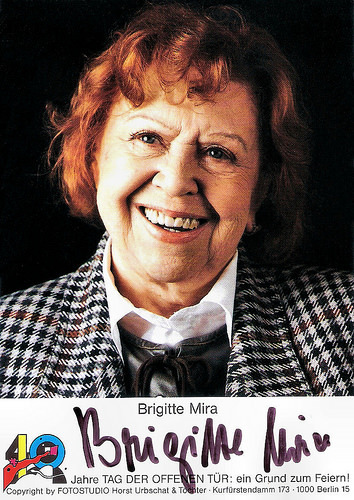
German promotion card. Photo: Fotostudio Horst Urbschat & Töchter, Berlin.
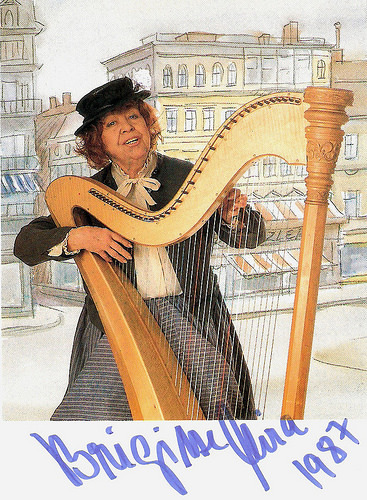
German autograph card by Funk Uhr. Caption: Funk Uhr präsentiert Brigitte Mira als "Harfenjule". (Funk Uhr presents Brigitte Mira as "Harfenjule"). Harfenjule was the nickname of the legendary Berlin street musician Luise Nordmann, née Schulz (1829-1911), but is now also a general German term for street singers.
Bad role model
Brigitte Mira was born in 1910 in Hamburg, but she moved early on to Berlin. Her father was the Russian Jewish pianist Siegfried Mira who had emigrated to Germany, and her mother was the German Elisabeth Strässner.
Brigitte began her stage career in Düsseldorf as a dancer under the name of Valencia Stramm. In the late 1920s, she debuted as a singer in the role of Esmeralda in Smetana's The Bartered Bride in Cologne. She also worked as a cabaret artist under the name of Gitta Mira.
During the Nazi era, Mira took part in the propaganda series Liese und Miese, short films that were produced to support the newsreels. She played Miese - the bad role model according to Nazi ideology—who listened to enemy radio stations and stockpiled rationed food. But her acting skills made her 'bad' character more popular than the good character Liese, portrayed by Gisela Schlüter.
After ten episodes the series was cancelled by the Ministry of Propaganda for being counterproductive. The propaganda directors did not know that Mira was half-Jewish, for she had false papers. Even though she insisted on her naiveté as a young woman and the fact she had to conceal her origins, she was criticized later by some for taking part in these ads at all.
After the war, Brigitte Mira made her film debut with a small part in the post-war satire Berliner Ballade/Berlin Ballad (Robert A. Stemmle, 1948) with Gert Fröbe. She played supporting parts in film operettas and lightweight comedies like the musical ...und abends in die Scala/An Evening at the Scala (Erik Ode, 1958) with Caterina Valente , and the musical comedy Der Stern von Santa Clara/The Star of Santa Clara (Werner Jacobs, 1958), starring Vico Torriani and Gerlinde Locker .
During the 1960s, Mira often played on television in shows and in TV-films like the comedy Der Vetter aus Dingsda/The Cousin from Dingsda (Imo Moszkowicz, 1960) with Birgit Bergen , the musical Frau Luna/Lady Moon (Thomas Engel, 1964) featuring Margit Schramm, and a Dutch-German version of Der Vetter aus Dingsda/The Cousin from Dingsda (Willy van Hemert, 1970), now with Mieke Bos. She also incidentally played in films, like the crime drama Das Stundenhotel von St. Pauli/Hotel by the Hour (Rolf Olsen, 1970) with Curd Jürgens .
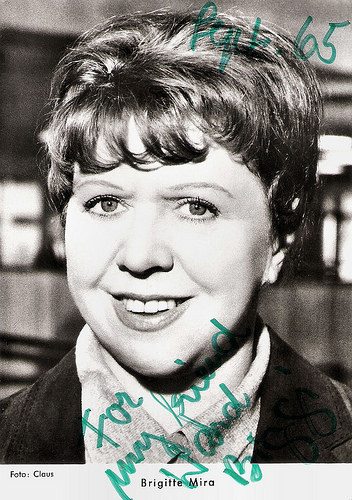
German postcard by Graphima, Berlin. Photo: Claus.

German promotion card by Ford Lorenz. Photo: Fotostudio Horst Urbschat & Töchter, Berlin.
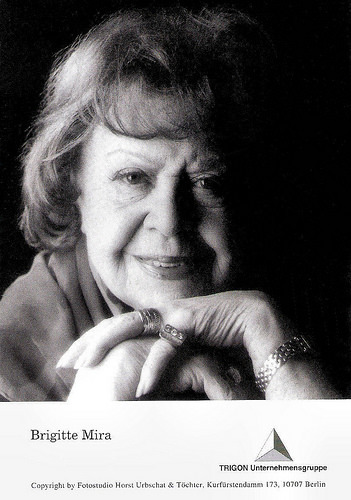
German promotion card by TRIGON Unternehmensgruppe. Photo: Fotostudio Horst Urbschat & Töchter, Berlin.
Fassbinder and the New German Wave
Brigitte Mira’s breakthrough followed in the 1970s when the West-German cinema was rejuvenated with the Neue Deutsche Welle – the New German Wave. She had a supporting part in the horror film Die Zärtlichkeit der Wölfe/The Tenderness of Wolves (Ulli Lommel, 1973) based on the crimes of German serial killer and cannibal Fritz Haarmann. It was written by Kurt Raab, who also stars in the film, and produced by Rainer Werner Fassbinder.
She also played a small part as the mother of Hanna Schygulla ’s character in the TV mini-series Acht Stunden sind kein Tag/Eight hours are not a day (Rainer Werner Fassbinder, 1973).
Then Fassbinder made Brigitte Mira a star when he gave her the leading role of Emmi Kurowski in Angst essen Seele auf/Fear Eats the Soul (Rainer Werner Fassbinder, 1974). The film revolves around an unlikely relationship which develops between an elderly woman (Mira) and a Moroccan migrant worker (El Hedi ben Salem) in post-war Germany. The film won two awards at the 1974 Cannes Film Festival and is considered to be one of Fassbinder's most powerful works. Brigitte Mira received the German Film Award for her performance.
She also worked with Werner Herzog on his film Jeder für sich und Gott gegen alle/The Enigma of Kaspar Hauser (Werner Herzog, 1974) starring Bruno Schleinstein as the foundling Kaspar Hauser. At the 1975 Cannes Film Festival, the film won the Grand Prix Spécial du Jury.
Mira starred in several more films by Rainer Werner Fassbinder, including Mutter Küsters' Fahrt zum Himmel/Mother Küsters' Trip to Heaven (Rainer Werner Fassbinder, 1975), Faustrecht der Freiheit/Fox and His Friends (Rainer Werner Fassbinder, 1975), starring Fassbinder himself, the TV film Angst vor der Angst/Fear of Fear (Rainer Werner Fassbinder, 1975), Satansbraten/Satan's Brew (Rainer Werner Fassbinder, 1976) with Kurt Raab, Chinesisches Roulette/Chinese Roulette (Rainer Werner Fassbinder, 1976) starring Margit Carstensen, and Fassbinder's magnum opus the TV series Berlin Alexanderplatz (Rainer Werner Fassbinder, 1980).
She also appeared in his box office hit Lili Marleen (Rainer Werner Fassbinder, 1980) featuring Hanna Schygulla . Another director with whom she worked several times was Wolf Gremm, e.g. on Kamikaze 1989 (1982).
In the 1980s Mira achieved another big success with the television series Drei Damen vom Grill/Three Ladies from the Snackbar (1976-1991). The series was about the Färber family (Margarete, Magda and Margot Färber) running a snackbar in West Berlin. Since the show not only depicts their work but was also received as a picture from the divided city of Berlin, Drei Damen vom Grill was discontinued shortly after the German Reunification.
She also worked as a voice acted and dubbed the Widow Tweed in Disney's The Fox and the Hound (1981). In 1991, Brigitte Mira appeared in the Berlin stage production of Stephen Sondheim's Follies.
During the late 1990s, Mira performed with Evelyn Künneke and Helen Vita in the self-deprecating song show Drei Alte Schachteln (Three old hags). Towards the end of her career Mira was regarded as a national treasure and in 1995 she was awarded the Bundesverdienstkreuz, the highest German decoration.
Brigitte Mira died in 2005 in Berlin. She was 94. She was married to Frank Guerente, Horst Fabian, Paul Cornelius, Reinhold Tabatt and actor Peter Schütte. In 2006 her final screen appearance in the TV film Aszendent Liebe/Ascendant love (Helmut Metzger, 2006) was posthumously shown.
Trailer Angst essen Seele auf/Fear Eats the Soul (1974). Source: retrotrailer (YouTube).
Brigitte Mira singing Leonard Cohen's Bird in a Wire in Wie ein Vogel auf dem Draht/Like a Bird on a Wire (Rainer Werner Fassbinder, 1975). Source: Bruno Colli (YouTube).
Sources: Wikipedia (German and English), and .

German promotion card. Photo: Fotostudio Horst Urbschat & Töchter, Berlin.

German autograph card by Funk Uhr. Caption: Funk Uhr präsentiert Brigitte Mira als "Harfenjule". (Funk Uhr presents Brigitte Mira as "Harfenjule"). Harfenjule was the nickname of the legendary Berlin street musician Luise Nordmann, née Schulz (1829-1911), but is now also a general German term for street singers.
Bad role model
Brigitte Mira was born in 1910 in Hamburg, but she moved early on to Berlin. Her father was the Russian Jewish pianist Siegfried Mira who had emigrated to Germany, and her mother was the German Elisabeth Strässner.
Brigitte began her stage career in Düsseldorf as a dancer under the name of Valencia Stramm. In the late 1920s, she debuted as a singer in the role of Esmeralda in Smetana's The Bartered Bride in Cologne. She also worked as a cabaret artist under the name of Gitta Mira.
During the Nazi era, Mira took part in the propaganda series Liese und Miese, short films that were produced to support the newsreels. She played Miese - the bad role model according to Nazi ideology—who listened to enemy radio stations and stockpiled rationed food. But her acting skills made her 'bad' character more popular than the good character Liese, portrayed by Gisela Schlüter.
After ten episodes the series was cancelled by the Ministry of Propaganda for being counterproductive. The propaganda directors did not know that Mira was half-Jewish, for she had false papers. Even though she insisted on her naiveté as a young woman and the fact she had to conceal her origins, she was criticized later by some for taking part in these ads at all.
After the war, Brigitte Mira made her film debut with a small part in the post-war satire Berliner Ballade/Berlin Ballad (Robert A. Stemmle, 1948) with Gert Fröbe. She played supporting parts in film operettas and lightweight comedies like the musical ...und abends in die Scala/An Evening at the Scala (Erik Ode, 1958) with Caterina Valente , and the musical comedy Der Stern von Santa Clara/The Star of Santa Clara (Werner Jacobs, 1958), starring Vico Torriani and Gerlinde Locker .
During the 1960s, Mira often played on television in shows and in TV-films like the comedy Der Vetter aus Dingsda/The Cousin from Dingsda (Imo Moszkowicz, 1960) with Birgit Bergen , the musical Frau Luna/Lady Moon (Thomas Engel, 1964) featuring Margit Schramm, and a Dutch-German version of Der Vetter aus Dingsda/The Cousin from Dingsda (Willy van Hemert, 1970), now with Mieke Bos. She also incidentally played in films, like the crime drama Das Stundenhotel von St. Pauli/Hotel by the Hour (Rolf Olsen, 1970) with Curd Jürgens .

German postcard by Graphima, Berlin. Photo: Claus.

German promotion card by Ford Lorenz. Photo: Fotostudio Horst Urbschat & Töchter, Berlin.

German promotion card by TRIGON Unternehmensgruppe. Photo: Fotostudio Horst Urbschat & Töchter, Berlin.
Fassbinder and the New German Wave
Brigitte Mira’s breakthrough followed in the 1970s when the West-German cinema was rejuvenated with the Neue Deutsche Welle – the New German Wave. She had a supporting part in the horror film Die Zärtlichkeit der Wölfe/The Tenderness of Wolves (Ulli Lommel, 1973) based on the crimes of German serial killer and cannibal Fritz Haarmann. It was written by Kurt Raab, who also stars in the film, and produced by Rainer Werner Fassbinder.
She also played a small part as the mother of Hanna Schygulla ’s character in the TV mini-series Acht Stunden sind kein Tag/Eight hours are not a day (Rainer Werner Fassbinder, 1973).
Then Fassbinder made Brigitte Mira a star when he gave her the leading role of Emmi Kurowski in Angst essen Seele auf/Fear Eats the Soul (Rainer Werner Fassbinder, 1974). The film revolves around an unlikely relationship which develops between an elderly woman (Mira) and a Moroccan migrant worker (El Hedi ben Salem) in post-war Germany. The film won two awards at the 1974 Cannes Film Festival and is considered to be one of Fassbinder's most powerful works. Brigitte Mira received the German Film Award for her performance.
She also worked with Werner Herzog on his film Jeder für sich und Gott gegen alle/The Enigma of Kaspar Hauser (Werner Herzog, 1974) starring Bruno Schleinstein as the foundling Kaspar Hauser. At the 1975 Cannes Film Festival, the film won the Grand Prix Spécial du Jury.
Mira starred in several more films by Rainer Werner Fassbinder, including Mutter Küsters' Fahrt zum Himmel/Mother Küsters' Trip to Heaven (Rainer Werner Fassbinder, 1975), Faustrecht der Freiheit/Fox and His Friends (Rainer Werner Fassbinder, 1975), starring Fassbinder himself, the TV film Angst vor der Angst/Fear of Fear (Rainer Werner Fassbinder, 1975), Satansbraten/Satan's Brew (Rainer Werner Fassbinder, 1976) with Kurt Raab, Chinesisches Roulette/Chinese Roulette (Rainer Werner Fassbinder, 1976) starring Margit Carstensen, and Fassbinder's magnum opus the TV series Berlin Alexanderplatz (Rainer Werner Fassbinder, 1980).
She also appeared in his box office hit Lili Marleen (Rainer Werner Fassbinder, 1980) featuring Hanna Schygulla . Another director with whom she worked several times was Wolf Gremm, e.g. on Kamikaze 1989 (1982).
In the 1980s Mira achieved another big success with the television series Drei Damen vom Grill/Three Ladies from the Snackbar (1976-1991). The series was about the Färber family (Margarete, Magda and Margot Färber) running a snackbar in West Berlin. Since the show not only depicts their work but was also received as a picture from the divided city of Berlin, Drei Damen vom Grill was discontinued shortly after the German Reunification.
She also worked as a voice acted and dubbed the Widow Tweed in Disney's The Fox and the Hound (1981). In 1991, Brigitte Mira appeared in the Berlin stage production of Stephen Sondheim's Follies.
During the late 1990s, Mira performed with Evelyn Künneke and Helen Vita in the self-deprecating song show Drei Alte Schachteln (Three old hags). Towards the end of her career Mira was regarded as a national treasure and in 1995 she was awarded the Bundesverdienstkreuz, the highest German decoration.
Brigitte Mira died in 2005 in Berlin. She was 94. She was married to Frank Guerente, Horst Fabian, Paul Cornelius, Reinhold Tabatt and actor Peter Schütte. In 2006 her final screen appearance in the TV film Aszendent Liebe/Ascendant love (Helmut Metzger, 2006) was posthumously shown.
Trailer Angst essen Seele auf/Fear Eats the Soul (1974). Source: retrotrailer (YouTube).
Brigitte Mira singing Leonard Cohen's Bird in a Wire in Wie ein Vogel auf dem Draht/Like a Bird on a Wire (Rainer Werner Fassbinder, 1975). Source: Bruno Colli (YouTube).
Sources: Wikipedia (German and English), and .
Published on September 03, 2016 22:00
September 2, 2016
Marius Goring
English stage and film actor Marius Goring (1912-1998) is best remembered for the four films he made with Powell & Pressburger, particularly as Conductor 71 in A Matter of Life and Death (1946) and as Julian Craster in The Red Shoes (1948). He also regularly performed French and German roles.
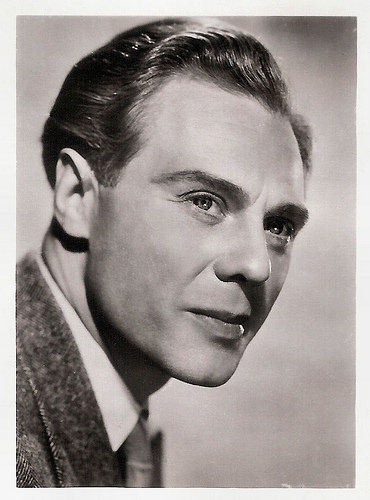
German collectors card in the series Filmstars der Welt 2. Band by Greiling-Sammelbilder, Serie E, Bild 105. Photo: Rank.
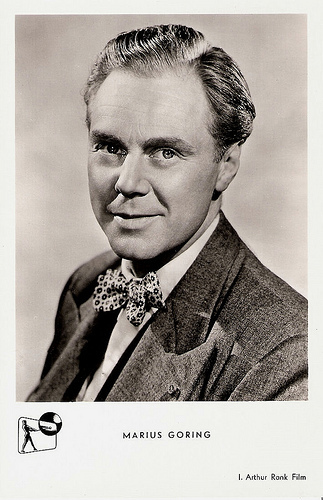
German postcard by Kunst und Bild, Berlin, no. A 1027. Photo: J. Arthur Rank Film. Publicity still for The Man Who Watched Trains Go By (Harold French, 1952).
Suave looks
Because of his suave looks, Marius Goring was often assumed to be foreign, but he was born in Newport, Isle of Wight, in 1912. He was the son of Dr. Charles Goring and Kate Macdonald. His father was a doctor and criminologist who died in the 1918 flu epidemic, when Marius was six.
At the Perse School in Cambridge, Marius became a friend of an older boy, the future documentary film maker Humphrey Jennings. He first performed professionally in 1927 and then studied under Harcourt Williams and at the Old Vic dramatic school from 1929 to 1932. He also studied at the universities of Frankfurt, Munich, Vienna and Paris.
His early stage career included appearances at the Old Vic, Sadler's Wells, Stratford and several European tours; he was fluent in French and German. He first worked in the West End in a 1934 revival of Granville-Barker's The Voysey Inheritance at the Shaftesbury Theatre. During the 1930s, he played a variety of Shakespearean roles, including Feste in Twelfth Night (1937), Macbeth and Romeo, in addition to Trip in Sheridan's The School for Scandal.
He made his film debut in Thornton Freeland's The Amateur Gentleman (1935), the screenplay of which was co-written by Clemence Dane. In 1939, he continued his film career with the British sports-drama Flying Fifty-Five (Reginald Denham, 1939) starring Derrick De Marney and based on a novel by Edgar Wallace.
That year, he also played a U-boat captain in The Spy in Black (1939), the first collaboration between the British filmmakers Michael Powell and Emeric Pressburger. They were brought together by Alexander Korda to make the World War I spy thriller by Joseph Storer Clouston into a film. The film, starring Conrad Veidt and Valerie Hobson , was named as one of the ten best films of 1939 by the National Board of Review.
During World War II, Marius Goring joined the army, becoming supervisor of BBC radio productions broadcasting to Germany and continued to act under the name Charles Richardson, because of the association of his name with Hermann Göring. Just after the outbreak of war, Goring caused a minor sensation when he portrayed Hitler on a radio series History of the Nazi Party. In 1941, he married his second wife, the actress Lucie Mannheim. The couple later worked together in the TV series The Adventures of the Scarlet Pimpernel (1955).
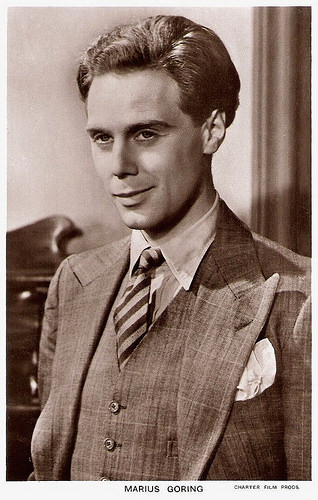
British postcard in the Picturegoer Series, London, no. 1425. Photo: Charter Film Prods. Publicity still for Pastor Hall (Roy Boulting, 1940).
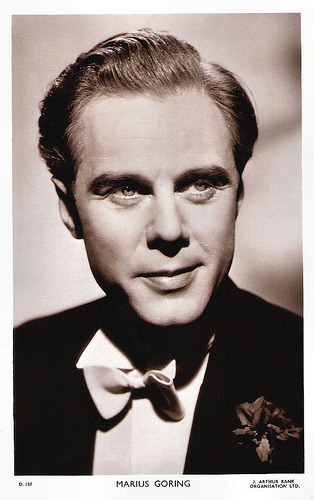
British postcard in the Picturegoer Series, London, no. D. 137. Photo: J. Arthur Rank Organisation.
My Little Operation
After the war, Marius Goring played the effete heavenly Conductor 71, the aristocrat who lost his head in the French Revolution ("my little operation") and who complains of the absence of Technicolor ‘up there’ in the romantic fantasy A Matter of Life and Death (Michael Powell and Emeric Pressburger, 1946). The film is set in England during the Second World War, and stars David Niven , Roger Livesey, Raymond Massey, Kim Hunter and Goring.
Two years later, Goring also starred in The Red Shoes (Michael Powell, Emeric Pressburger, 1948). The film employs the story within a story device, being about a young ballerina ( Moira Shearer ) who joins an established ballet company and becomes the lead dancer in a new ballet called The Red Shoes, itself based on the fairy tale The Red Shoes by Hans Christian Andersen. Goring played the young composer in love with the doomed ballerina.
Later he also worked in Powell and Pressbuger’s Ill Met by Moonlight (1957), starring Dirk Bogarde . Other well-known films with Goring are Pandora and the Flying Dutchman (Albert Lewin, 1951) starring Ava Gardner , the Georges Simenon adaptation The Man Who Watched Trains Go By (Harold French, 1952) starring Claude Rains , The Barefoot Contessa (Joseph L. Mankiewicz, 1954) with Humphrey Bogart and Ava Gardner , and The Angry Hills (Robert Aldrich, 1959) with Robert Mitchum.
During the 1960s followed the epic Exodus (Otto Preminger, 1960), The Girl on a Motorcycle (Jack Cardiff, 1968) with Alain Delon and Marianne Faithful, and Erste Liebe/First Love (Maximilian Schell,1970). His final film was the French drama La petite fille en velours bleu/Little Girl in Blue Velvet (Alan Bridges, 1978), starring Michel Piccoli and Claudia Cardinale .
Goring’s TV work included starring as Sir Percy Blakeney in The Adventures of the Scarlet Pimpernel (1955), a series which he also co-wrote and produced; Theodore Maxtible in the Doctor Who story The Evil of the Daleks (1967); the title role in The Expert (1968–1976); King George V in Edward & Mrs. Simpson (1980); and The Old Men at the Zoo (1983).
Goring was a founding member of British Equity, the actors' union, and he became its president from 1963 to 1965, and again from 1975 to 1982. Goring's relationship with his union was fraught with conflict: he took it to litigation on three occasions. In 1992 he unsuccessfully sought to end the block on the sale of radio and television programmes to (the still) apartheid South Africa. He was appointed Commander of the Order of the British Empire (CBE) in 1991.
In 1998, Marius Goring died from cancer in Heathfield, Easst Sussex, He was 86. His wife Lucie Mannheim had died in 1976. The next year Goring had married television producer Prudence Fitzgerald, who survived him.
DVD trailer The Spy in Black (1939). Source: Video Detective (YouTube).
Trailer The Red Shoes (1948). Source: Movieclips Trailer Vault (YouTube).
Trailer The Barefoot Contessa (1954). Source: Movieclips Trailer Vault (YouTube).
Trailer Ill Met by Moonlight (1957). Source: Trailer Park - Film & TV (YouTube).
Sources: Brian McFarlane (Encyclopedia of British Film), Tom Vallance (The Independent), Wikipedia and .

German collectors card in the series Filmstars der Welt 2. Band by Greiling-Sammelbilder, Serie E, Bild 105. Photo: Rank.

German postcard by Kunst und Bild, Berlin, no. A 1027. Photo: J. Arthur Rank Film. Publicity still for The Man Who Watched Trains Go By (Harold French, 1952).
Suave looks
Because of his suave looks, Marius Goring was often assumed to be foreign, but he was born in Newport, Isle of Wight, in 1912. He was the son of Dr. Charles Goring and Kate Macdonald. His father was a doctor and criminologist who died in the 1918 flu epidemic, when Marius was six.
At the Perse School in Cambridge, Marius became a friend of an older boy, the future documentary film maker Humphrey Jennings. He first performed professionally in 1927 and then studied under Harcourt Williams and at the Old Vic dramatic school from 1929 to 1932. He also studied at the universities of Frankfurt, Munich, Vienna and Paris.
His early stage career included appearances at the Old Vic, Sadler's Wells, Stratford and several European tours; he was fluent in French and German. He first worked in the West End in a 1934 revival of Granville-Barker's The Voysey Inheritance at the Shaftesbury Theatre. During the 1930s, he played a variety of Shakespearean roles, including Feste in Twelfth Night (1937), Macbeth and Romeo, in addition to Trip in Sheridan's The School for Scandal.
He made his film debut in Thornton Freeland's The Amateur Gentleman (1935), the screenplay of which was co-written by Clemence Dane. In 1939, he continued his film career with the British sports-drama Flying Fifty-Five (Reginald Denham, 1939) starring Derrick De Marney and based on a novel by Edgar Wallace.
That year, he also played a U-boat captain in The Spy in Black (1939), the first collaboration between the British filmmakers Michael Powell and Emeric Pressburger. They were brought together by Alexander Korda to make the World War I spy thriller by Joseph Storer Clouston into a film. The film, starring Conrad Veidt and Valerie Hobson , was named as one of the ten best films of 1939 by the National Board of Review.
During World War II, Marius Goring joined the army, becoming supervisor of BBC radio productions broadcasting to Germany and continued to act under the name Charles Richardson, because of the association of his name with Hermann Göring. Just after the outbreak of war, Goring caused a minor sensation when he portrayed Hitler on a radio series History of the Nazi Party. In 1941, he married his second wife, the actress Lucie Mannheim. The couple later worked together in the TV series The Adventures of the Scarlet Pimpernel (1955).

British postcard in the Picturegoer Series, London, no. 1425. Photo: Charter Film Prods. Publicity still for Pastor Hall (Roy Boulting, 1940).

British postcard in the Picturegoer Series, London, no. D. 137. Photo: J. Arthur Rank Organisation.
My Little Operation
After the war, Marius Goring played the effete heavenly Conductor 71, the aristocrat who lost his head in the French Revolution ("my little operation") and who complains of the absence of Technicolor ‘up there’ in the romantic fantasy A Matter of Life and Death (Michael Powell and Emeric Pressburger, 1946). The film is set in England during the Second World War, and stars David Niven , Roger Livesey, Raymond Massey, Kim Hunter and Goring.
Two years later, Goring also starred in The Red Shoes (Michael Powell, Emeric Pressburger, 1948). The film employs the story within a story device, being about a young ballerina ( Moira Shearer ) who joins an established ballet company and becomes the lead dancer in a new ballet called The Red Shoes, itself based on the fairy tale The Red Shoes by Hans Christian Andersen. Goring played the young composer in love with the doomed ballerina.
Later he also worked in Powell and Pressbuger’s Ill Met by Moonlight (1957), starring Dirk Bogarde . Other well-known films with Goring are Pandora and the Flying Dutchman (Albert Lewin, 1951) starring Ava Gardner , the Georges Simenon adaptation The Man Who Watched Trains Go By (Harold French, 1952) starring Claude Rains , The Barefoot Contessa (Joseph L. Mankiewicz, 1954) with Humphrey Bogart and Ava Gardner , and The Angry Hills (Robert Aldrich, 1959) with Robert Mitchum.
During the 1960s followed the epic Exodus (Otto Preminger, 1960), The Girl on a Motorcycle (Jack Cardiff, 1968) with Alain Delon and Marianne Faithful, and Erste Liebe/First Love (Maximilian Schell,1970). His final film was the French drama La petite fille en velours bleu/Little Girl in Blue Velvet (Alan Bridges, 1978), starring Michel Piccoli and Claudia Cardinale .
Goring’s TV work included starring as Sir Percy Blakeney in The Adventures of the Scarlet Pimpernel (1955), a series which he also co-wrote and produced; Theodore Maxtible in the Doctor Who story The Evil of the Daleks (1967); the title role in The Expert (1968–1976); King George V in Edward & Mrs. Simpson (1980); and The Old Men at the Zoo (1983).
Goring was a founding member of British Equity, the actors' union, and he became its president from 1963 to 1965, and again from 1975 to 1982. Goring's relationship with his union was fraught with conflict: he took it to litigation on three occasions. In 1992 he unsuccessfully sought to end the block on the sale of radio and television programmes to (the still) apartheid South Africa. He was appointed Commander of the Order of the British Empire (CBE) in 1991.
In 1998, Marius Goring died from cancer in Heathfield, Easst Sussex, He was 86. His wife Lucie Mannheim had died in 1976. The next year Goring had married television producer Prudence Fitzgerald, who survived him.
DVD trailer The Spy in Black (1939). Source: Video Detective (YouTube).
Trailer The Red Shoes (1948). Source: Movieclips Trailer Vault (YouTube).
Trailer The Barefoot Contessa (1954). Source: Movieclips Trailer Vault (YouTube).
Trailer Ill Met by Moonlight (1957). Source: Trailer Park - Film & TV (YouTube).
Sources: Brian McFarlane (Encyclopedia of British Film), Tom Vallance (The Independent), Wikipedia and .
Published on September 02, 2016 22:00
September 1, 2016
EFSP's Dazzling Dozen: A Night at the Opera
Nowadays, you can enjoy a night at The Metropolitan Opera in New York in your local cinema. In December 2006, The Met started a series of performance transmissions shown live in high definition in cinemas around the world. The series expanded from an initial six transmissions to 10 in the 2014–2015 season and today reaches more than 2,000 venues in 70 countries across six continents. But long before these transmissions started, several opera stars were already very popular in the cinema. Today 12 dazzling postcards of opera performers who also became film stars.

Lina Cavalieri . French postcard by S.I.P., no. 1188. Sent by mail in 1905. Photo: Reutlinger, Paris.
Around 1900, Italian soprano Lina Cavalieri (1874-1944) was considered the most beautiful woman on earth. In the 1910s, she pursued a career in the silent cinema in Italy and in the United States.
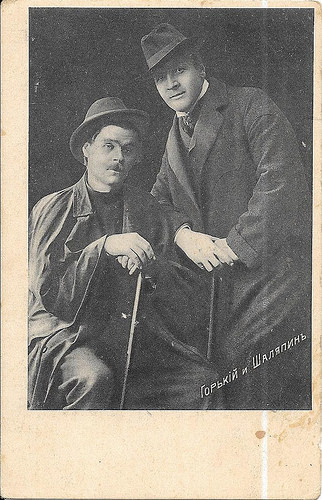
Maxim Gorky and Feodor Chaliapin. Russian postcard. Collection: Didier Hanson.
Feodor Ivanovich Chaliapin (Russian: Фёдор Ива́нович Шаля́пин) (1873–1938) was a Russian opera singer. The possessor of a large, deep and expressive bass voice, he enjoyed an important international career at major opera houses and is often credited with establishing the tradition of naturalistic acting in his chosen art form. The only sound film which shows his acting style is Don Quixote (Georg Wilhelm Pabst, 1933). Chaliapin collaborated with novelist Maxim Gorky, who wrote and edited his memoirs, which he published in 1933.
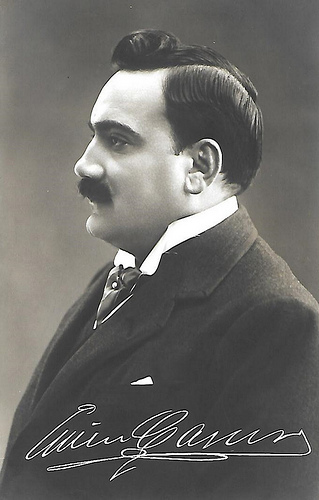
Enrico Caruso. Italian postcard. Collection: Didier Hanson.
Enrico Caruso (1873-1921) was an Italian operatic tenor. He sang to great acclaim at the major opera houses of Europe and the Americas, appearing in a wide variety of roles from the Italian and French repertoires that ranged from the lyric to the dramatic. Between 1908 and 1919 he appeared in five films.
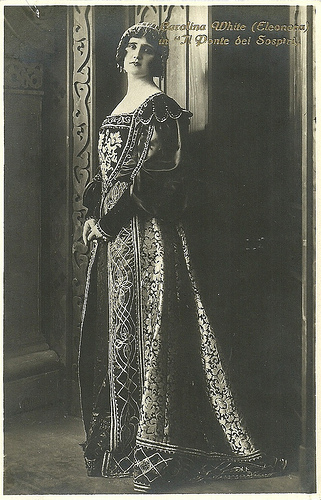
Carolina White. Italian postcard by Ed. G.B. Falci, Milano, no. 56. Photo: La Fotominio. Publicity still for Il ponte dei sospiri (Domenico Gaido, 1921).
American opera singer Carolina White (1885-1961) had a short-lived film career. She played opposite the famous opera singer Enrico Caruso in My Cousin (Edward José, 1918). In 1921 she played the love interest of Luciano Albertini in the 4-part episode film Il ponte dei sospiri, directed by Domenico Gaido, and partly shot on location in Venice. After that White didn't act in film anymore. She died in Rome in 1961.
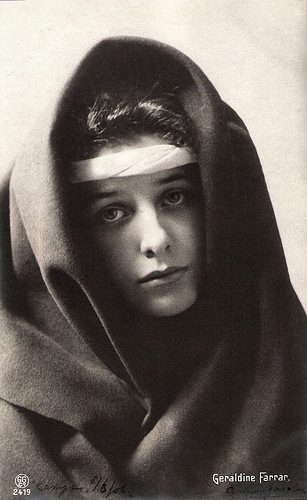
Geraldine Farrar. Dutch postcard by GG Co., no. 2419.
American silent film star Geraldine Farrar (1882-1967) was one of the most famous opera singers of the early twentieth century and one of the great beauties of her day. She had a large following among young women, who were nicknamed 'Gerry-flappers'. From 1915 to 1920, she also starred in more than a dozen films, which were filmed during the then traditional 8 week summer hiatus from the opera house and concert hall. Her films included Cecil B. De Mille's adaptation of Georges Bizet's opera Carmen (1915). One of her most notable screen roles was as Joan of Arc in Joan the Woman (Cecil B. DeMille, 1917).
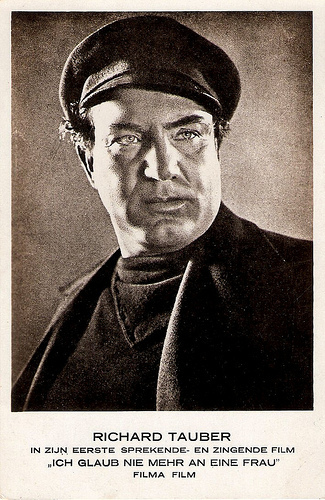
Richard Tauber . Dutch postcard. Photo: Filma Film. Publicity still for Ich glaub nie mehr an eine Frau (Max Reichmann, 1930).
Austrian opera singer Richard Tauber (1891-1948) was one of the world's finest Mozartian tenors of the 20th century. Some critics commented that "his heart felt every word he sang". He also tested the then new talking pictures in such popular musical films as Ich küsse Ihre Hand, Madame (1929) with Marlene Dietrich, Das Land des Lächelns (1930) and Melodie der Liebe (1932).
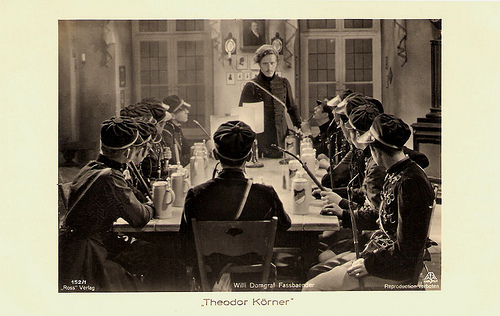
Willi Domgraf Fassbaender . German postcard by Ross Verlag, no. 152/1, 1932. Photo: Aafa Film. Publicity still for Theodor Körner (Carl Boese, 1932).
Celebrated German opera singer Willi Domgraf Fassbaender (1897–1978) was one of the leading lyric baritones of the inter-war period. He was particularly associated with Mozart and Italian roles. ‘The Italian baritone’ starred in the 1930’s in a number of musical films, which helped his shining international reputation.
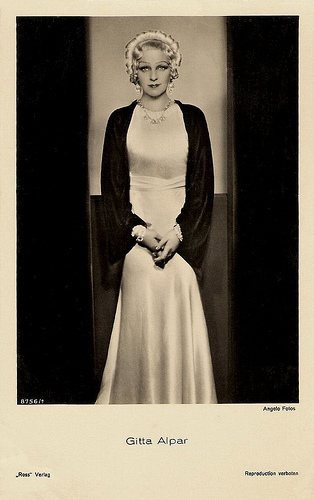
Gitta Alpár . German postcard by Ross Verlag, no. 8756/1, 1933-1934. Photo: Angelo Fotos.
Hungarian-born Gitta Alpár (1903-1991) was a Jewish actress, opera and operetta singer, and dancer, whose career in Germany was broken by the Nazis.
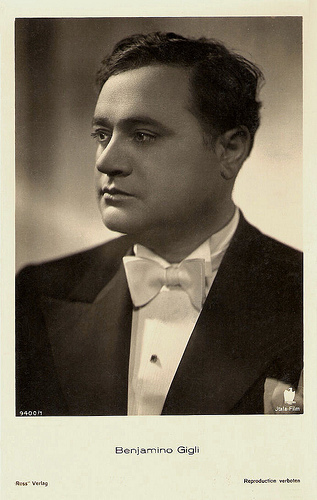
Beniamino Gigli . German postcard by Ross Verlag, no. 9400/1, 1935-1936. Photo: Itala Film.
Actor and opera singer Beniamino Gigli (1890-1957) was one of the most famous Italian tenors, internationally respected for the beauty of his voice and his vocal technique. Between 1935 and 1950, 'Benito Mussolini's favourite singer' also starred in various German and Italian entertainment films.
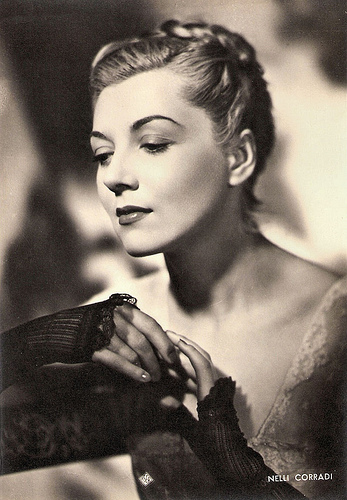
Nelly Corradi. Italian postcard by ASER, no. 173. Photo: De Antonis.
Beautiful Nelly Corradi (1914–1968) was an Italian opera singer and actress. She made her film debut in Max Ophüls’s La signora di tutti (1934) and had her biggest successes after the war with opera films like Lucia di Lammermoor (1946).
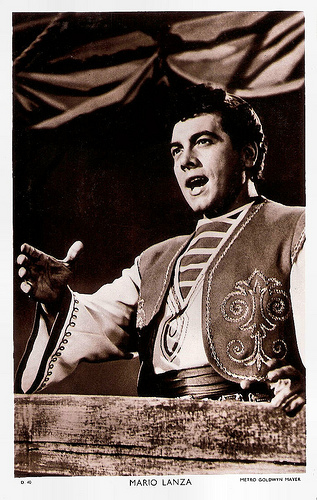
Mario Lanza. British postcard in the Picturegoer Series, London, no. D 40. Photo: Metro-Goldwyn-Mayer. Publicity still for The Great Caruso (Richard Thorpe, 1951).
Mario Lanza (1921–1959) was an American tenor, actor and Hollywood film star of the late 1940s and the 1950s. His masterpiece was The Great Caruso (Richard Thorpe, 1951), the top-grossing film in the world in 1951. Lanza's voice was so dazzling that an awestruck Arturo Toscanini called it the "voice of the century".
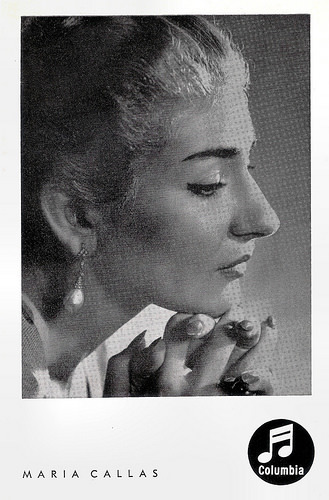
Maria Callas. German promotion card by Columbia, no. DrW 2946 d. Photo: Angus McBean.
Greek-American soprano Maria Callas (1923–1977) was one of the most renowned and influential opera singers of the 20th century. Many critics praised her bel canto technique, wide-ranging voice and dramatic interpretations. Her repertoire ranged from classical opera seria to the bel canto operas of Donizetti, Bellini and Rossini and further, to the works of Verdi and Puccini; and, in her early career, to the music dramas of Wagner. Her musical and dramatic talents led to her being hailed as La Divina. Her most famous film appearance was the title role in Pier Paolo Pasolini's Medea (1969).
Sources: The Metropolitan Opera, Wikipedia and
This is a post for Postcard Friendship Friday, hosted by Beth at the The Best Hearts are Crunchy. You can visit her by clicking on the button below.


Lina Cavalieri . French postcard by S.I.P., no. 1188. Sent by mail in 1905. Photo: Reutlinger, Paris.
Around 1900, Italian soprano Lina Cavalieri (1874-1944) was considered the most beautiful woman on earth. In the 1910s, she pursued a career in the silent cinema in Italy and in the United States.

Maxim Gorky and Feodor Chaliapin. Russian postcard. Collection: Didier Hanson.
Feodor Ivanovich Chaliapin (Russian: Фёдор Ива́нович Шаля́пин) (1873–1938) was a Russian opera singer. The possessor of a large, deep and expressive bass voice, he enjoyed an important international career at major opera houses and is often credited with establishing the tradition of naturalistic acting in his chosen art form. The only sound film which shows his acting style is Don Quixote (Georg Wilhelm Pabst, 1933). Chaliapin collaborated with novelist Maxim Gorky, who wrote and edited his memoirs, which he published in 1933.

Enrico Caruso. Italian postcard. Collection: Didier Hanson.
Enrico Caruso (1873-1921) was an Italian operatic tenor. He sang to great acclaim at the major opera houses of Europe and the Americas, appearing in a wide variety of roles from the Italian and French repertoires that ranged from the lyric to the dramatic. Between 1908 and 1919 he appeared in five films.

Carolina White. Italian postcard by Ed. G.B. Falci, Milano, no. 56. Photo: La Fotominio. Publicity still for Il ponte dei sospiri (Domenico Gaido, 1921).
American opera singer Carolina White (1885-1961) had a short-lived film career. She played opposite the famous opera singer Enrico Caruso in My Cousin (Edward José, 1918). In 1921 she played the love interest of Luciano Albertini in the 4-part episode film Il ponte dei sospiri, directed by Domenico Gaido, and partly shot on location in Venice. After that White didn't act in film anymore. She died in Rome in 1961.

Geraldine Farrar. Dutch postcard by GG Co., no. 2419.
American silent film star Geraldine Farrar (1882-1967) was one of the most famous opera singers of the early twentieth century and one of the great beauties of her day. She had a large following among young women, who were nicknamed 'Gerry-flappers'. From 1915 to 1920, she also starred in more than a dozen films, which were filmed during the then traditional 8 week summer hiatus from the opera house and concert hall. Her films included Cecil B. De Mille's adaptation of Georges Bizet's opera Carmen (1915). One of her most notable screen roles was as Joan of Arc in Joan the Woman (Cecil B. DeMille, 1917).

Richard Tauber . Dutch postcard. Photo: Filma Film. Publicity still for Ich glaub nie mehr an eine Frau (Max Reichmann, 1930).
Austrian opera singer Richard Tauber (1891-1948) was one of the world's finest Mozartian tenors of the 20th century. Some critics commented that "his heart felt every word he sang". He also tested the then new talking pictures in such popular musical films as Ich küsse Ihre Hand, Madame (1929) with Marlene Dietrich, Das Land des Lächelns (1930) and Melodie der Liebe (1932).

Willi Domgraf Fassbaender . German postcard by Ross Verlag, no. 152/1, 1932. Photo: Aafa Film. Publicity still for Theodor Körner (Carl Boese, 1932).
Celebrated German opera singer Willi Domgraf Fassbaender (1897–1978) was one of the leading lyric baritones of the inter-war period. He was particularly associated with Mozart and Italian roles. ‘The Italian baritone’ starred in the 1930’s in a number of musical films, which helped his shining international reputation.

Gitta Alpár . German postcard by Ross Verlag, no. 8756/1, 1933-1934. Photo: Angelo Fotos.
Hungarian-born Gitta Alpár (1903-1991) was a Jewish actress, opera and operetta singer, and dancer, whose career in Germany was broken by the Nazis.

Beniamino Gigli . German postcard by Ross Verlag, no. 9400/1, 1935-1936. Photo: Itala Film.
Actor and opera singer Beniamino Gigli (1890-1957) was one of the most famous Italian tenors, internationally respected for the beauty of his voice and his vocal technique. Between 1935 and 1950, 'Benito Mussolini's favourite singer' also starred in various German and Italian entertainment films.

Nelly Corradi. Italian postcard by ASER, no. 173. Photo: De Antonis.
Beautiful Nelly Corradi (1914–1968) was an Italian opera singer and actress. She made her film debut in Max Ophüls’s La signora di tutti (1934) and had her biggest successes after the war with opera films like Lucia di Lammermoor (1946).

Mario Lanza. British postcard in the Picturegoer Series, London, no. D 40. Photo: Metro-Goldwyn-Mayer. Publicity still for The Great Caruso (Richard Thorpe, 1951).
Mario Lanza (1921–1959) was an American tenor, actor and Hollywood film star of the late 1940s and the 1950s. His masterpiece was The Great Caruso (Richard Thorpe, 1951), the top-grossing film in the world in 1951. Lanza's voice was so dazzling that an awestruck Arturo Toscanini called it the "voice of the century".

Maria Callas. German promotion card by Columbia, no. DrW 2946 d. Photo: Angus McBean.
Greek-American soprano Maria Callas (1923–1977) was one of the most renowned and influential opera singers of the 20th century. Many critics praised her bel canto technique, wide-ranging voice and dramatic interpretations. Her repertoire ranged from classical opera seria to the bel canto operas of Donizetti, Bellini and Rossini and further, to the works of Verdi and Puccini; and, in her early career, to the music dramas of Wagner. Her musical and dramatic talents led to her being hailed as La Divina. Her most famous film appearance was the title role in Pier Paolo Pasolini's Medea (1969).
Sources: The Metropolitan Opera, Wikipedia and
This is a post for Postcard Friendship Friday, hosted by Beth at the The Best Hearts are Crunchy. You can visit her by clicking on the button below.

Published on September 01, 2016 22:00
August 31, 2016
Dominique Boschero
Among cult film fans, French actress Dominique Boschero (1934) is famous for her roles in dozens of Giallos and Spaghetti Westerns. The gorgeous brunette appeared in a surprisingly large amount of French and Italian films from the mid-1950s to the mid 1980s.
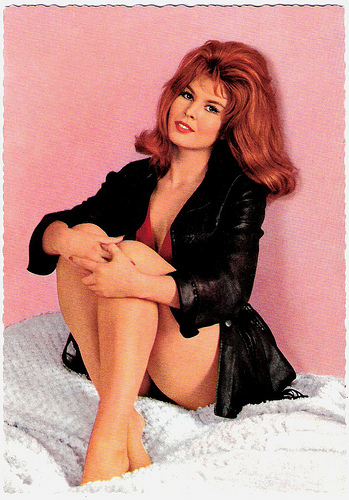
German postcard by Krüger, no. 902/357. Photo: Georg Michalke.
Showgirl
Dominique Boschero was born in Paris, France in 1934. She is the sister of actor-producer Martial Boschero. Their parents were Italian and when World War II broke out, the 5-year old Dominique was trusted in the hands of her grandparents in Frassino, a small Italian mountain village with a few hundred of inhabitants. There she grew up.
At 15, she returned to Paris and started to work as a janitor in a hospital and later she worked as a seamstress. With her tall length and her dark beauty, she found work as a model. Soon her beautiful face was on the covers of Paris’s premiere fashion magazines.
At the age of 18, she made her stage debut as a showgirl at the Paris music-hall La Nouvelle Eve (The New Eve). She also played small or uncredited roles in French films, such as Club de Femmes/Club of Women (Ralph Habib, 1956) with Nicole Courcel and Dany Carrel .
A year later, Boschero had a bigger part in Printemps a Paris/Springtime in Paris (Jean-Claude Roy, 1957) with Christine Carère and Philippe Nicaud. She got another bigger role in Delannoy's Le baron de l'ecluse/The Baron of the Locks (Jean Delannoy, 1960) starring Jean Gabin and Micheline Presle .
Following an interview with the Italian magazine Epoca, Dominique Boschero was noticed by an Italian producer, who invited her to come to the capital of the European cinema at the time, Rome.
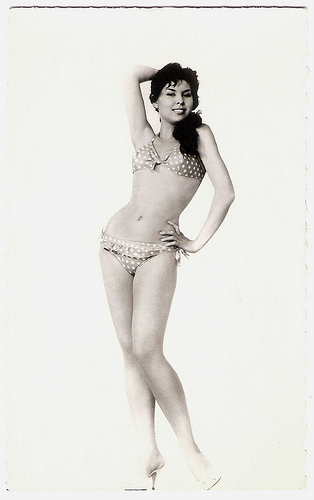
French postcard by Editions P.I., Paris, no. 892. Offered by les Carbones Korès 'Carboplane'. Photo: Sam Lévin.
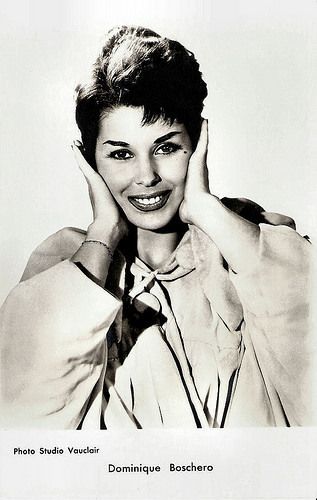
French postcard by Editions P.I., Paris, offered by Les Carbones Korès 'Carboplane', no. 1106. Photo: Studio Vauclair.
Queen of the Bird Men
Dominique Boschero headed off to Italy, beginning her Italian career with the Western comedy Un dollaro di fifa/A Dollar of Funk (Giorgio Simonelli, 1960), a spoof of Rio Bravo (Howard Hawks, 1959), which also starred Ugo Tognazzi and Walter Chiari .
She then appeared in a few Peplums (Sword and sandal films). Most notably was her winning performance as 'Queen of the Bird Men' in Ulisse contro Ercole/Ulysses Against Hercules (Mario Caiano, 1962) starring Georges Marchal .
Then she made a major impact as femme fatale in several Eurospy films. She appeared in early German/Italian examples of the genre such as Heißer Hafen Hong Kong/Hong Kong Hot Harbor (Jürgen Roland, 1962) with Marianne Koch , and Das geheimnis der chinesischen Nelke/The Secret of the Chinese Carnation (Rudolf Zehetgruber, 1964) starring Paul Dahlke . In the latter she appeared as a voluptuous vamp in a deadly plot of three different groups of plotting agents. They all chase after a microfilm with a secret formula for a new rocket fuel.
Then, she appeared opposite Giancarlo Giannini in his film debut, the interesting thriller Libido (Ernesto Gastaldi, Vittorio Salerno, 1965). Boschero played another leading role in Furia in Marakech/Fury at Marrakesh (Mino Loy, Luciano Martino, 1966).
According to Tom Lisanti and Louis Paul, authors of the study Film Fatales, Boschero's ‘ultimate screen appearance’, was “her screen-stealing turn in the bizarre uninhibited wacky, wild and completely unbelievable secret agent-super hero hybrid” Come Rubare la Corona d’Inghilterra/Argoman the Fantastic Superman (Sergio Grieco, 1967). Boschero at first appears as a seemingly lost and helpless woman who seduces Argoman (Roger Browne) and then turns out to be a mastermind villain. At the climax of the film, she sadistically tortures Argoman and tries to remove his magic powers permanently. At IMDb, reviewer Gulaq-2 writes: “A CAMP classic of maximum proportions, which ruled the world in the late sixties, conquering all the known B-movies markets”.
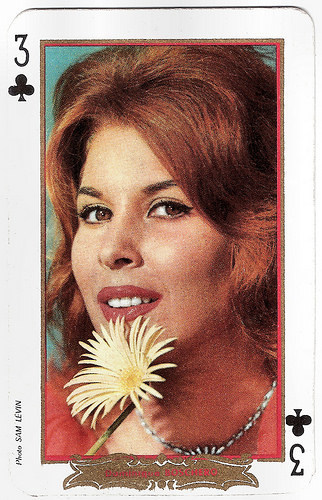
French playing card. Photo: Sam Lévin.
Guilty Pleasure
In the 1970s, Dominique Boschero continued popping up in such Giallos as Chi l'ha vista morire?/Who Saw Her Die (Aldo Lado, 1972) starring former James Bond George Lazenby, and Tutti i colori del buio/All the Colors of the Dark (Sergio Martino, 1972) with George Hilton and Edwige Fenech.
She also appeared in the Spaghetti Western Los buitres cavarán tu fosa/And the Crows Will Dig Your Grave (Juan Bosch, 1972), the Italian-Belgian sex comedy Je suis une call-girl/I am a call-girl (Jack Guy, 1973), and the horror film Il prato macchiato di rosso/The Bloodstained Lawn (Riccardo Ghione, 1973) with Nino Castelnuovo.
IMDb reviewer Babycarrot67 calls this horror film a 'guilty pleasure': “An obvious commentary on the rich and powerful exploiting the more unfortunate members of society, this film does not take itself very seriously, and most of the cast, especially Marina Malfatti as one of the aristocrats, appears to be having a good time. The film's claustrophobic atmosphere gives it just enough feeling of unease to make it a credible horror film, and the film's overall weirdness and eccentricity help it cross over the finish line of viewer satisfaction. This film could be the definition of a motion picture 'guilty pleasure' although one should not feel guilty during the viewing”.
Boschero had a romance with Claudio Camaso (Claudio Volonté), the brother of actor Gianmaria Volonté. Camaso was involved with an alleged bomb in the Vatican. This scandal and her cursed relationship with the actor who eventually committed suicide in jail in 1977, slowed down her career. In 1974 Boschero retired from the cinema and withdrew to Frassino. She later would have a relation with the singer Franco Califano.
In 1986 she returned on television in the soap series Passioni/Passions (Riccardo Donna, 1986). Dominique Boschero lives in Frassino, North-West Italy, where she is involved in the investigation and preservation of the occitan language. From the end of the 1960s she is interested in this subject after meeting François Fontan, founder of the Parti nationaliste occitan, and the poet Antonio Bodrero (Barba Toni Baudrier).
Trailer Libido (1965). Source: neverlando74 (YouTube).
Trailer Come Rubare la Corona d’Inghilterra/Argoman the Fantastic Superman (1967). Source: Jordotech (YouTube).
Italian trailer for the Spaghetti Western Un Treno per Durango/A Train To Durango (1968). Source: Neverlando74 (YouTube).
International trailer for Chi l'ha vista morire?/Who Saw Her Die (1972). Source: Italo-Cinema Trailer (YouTube).
Sources: Tom Lisanti and Louis Paul (Film Fatales: women in espionage films and television, 1962-1973), European Film Review, Wikipedia (French and Italian), and .

German postcard by Krüger, no. 902/357. Photo: Georg Michalke.
Showgirl
Dominique Boschero was born in Paris, France in 1934. She is the sister of actor-producer Martial Boschero. Their parents were Italian and when World War II broke out, the 5-year old Dominique was trusted in the hands of her grandparents in Frassino, a small Italian mountain village with a few hundred of inhabitants. There she grew up.
At 15, she returned to Paris and started to work as a janitor in a hospital and later she worked as a seamstress. With her tall length and her dark beauty, she found work as a model. Soon her beautiful face was on the covers of Paris’s premiere fashion magazines.
At the age of 18, she made her stage debut as a showgirl at the Paris music-hall La Nouvelle Eve (The New Eve). She also played small or uncredited roles in French films, such as Club de Femmes/Club of Women (Ralph Habib, 1956) with Nicole Courcel and Dany Carrel .
A year later, Boschero had a bigger part in Printemps a Paris/Springtime in Paris (Jean-Claude Roy, 1957) with Christine Carère and Philippe Nicaud. She got another bigger role in Delannoy's Le baron de l'ecluse/The Baron of the Locks (Jean Delannoy, 1960) starring Jean Gabin and Micheline Presle .
Following an interview with the Italian magazine Epoca, Dominique Boschero was noticed by an Italian producer, who invited her to come to the capital of the European cinema at the time, Rome.

French postcard by Editions P.I., Paris, no. 892. Offered by les Carbones Korès 'Carboplane'. Photo: Sam Lévin.

French postcard by Editions P.I., Paris, offered by Les Carbones Korès 'Carboplane', no. 1106. Photo: Studio Vauclair.
Queen of the Bird Men
Dominique Boschero headed off to Italy, beginning her Italian career with the Western comedy Un dollaro di fifa/A Dollar of Funk (Giorgio Simonelli, 1960), a spoof of Rio Bravo (Howard Hawks, 1959), which also starred Ugo Tognazzi and Walter Chiari .
She then appeared in a few Peplums (Sword and sandal films). Most notably was her winning performance as 'Queen of the Bird Men' in Ulisse contro Ercole/Ulysses Against Hercules (Mario Caiano, 1962) starring Georges Marchal .
Then she made a major impact as femme fatale in several Eurospy films. She appeared in early German/Italian examples of the genre such as Heißer Hafen Hong Kong/Hong Kong Hot Harbor (Jürgen Roland, 1962) with Marianne Koch , and Das geheimnis der chinesischen Nelke/The Secret of the Chinese Carnation (Rudolf Zehetgruber, 1964) starring Paul Dahlke . In the latter she appeared as a voluptuous vamp in a deadly plot of three different groups of plotting agents. They all chase after a microfilm with a secret formula for a new rocket fuel.
Then, she appeared opposite Giancarlo Giannini in his film debut, the interesting thriller Libido (Ernesto Gastaldi, Vittorio Salerno, 1965). Boschero played another leading role in Furia in Marakech/Fury at Marrakesh (Mino Loy, Luciano Martino, 1966).
According to Tom Lisanti and Louis Paul, authors of the study Film Fatales, Boschero's ‘ultimate screen appearance’, was “her screen-stealing turn in the bizarre uninhibited wacky, wild and completely unbelievable secret agent-super hero hybrid” Come Rubare la Corona d’Inghilterra/Argoman the Fantastic Superman (Sergio Grieco, 1967). Boschero at first appears as a seemingly lost and helpless woman who seduces Argoman (Roger Browne) and then turns out to be a mastermind villain. At the climax of the film, she sadistically tortures Argoman and tries to remove his magic powers permanently. At IMDb, reviewer Gulaq-2 writes: “A CAMP classic of maximum proportions, which ruled the world in the late sixties, conquering all the known B-movies markets”.

French playing card. Photo: Sam Lévin.
Guilty Pleasure
In the 1970s, Dominique Boschero continued popping up in such Giallos as Chi l'ha vista morire?/Who Saw Her Die (Aldo Lado, 1972) starring former James Bond George Lazenby, and Tutti i colori del buio/All the Colors of the Dark (Sergio Martino, 1972) with George Hilton and Edwige Fenech.
She also appeared in the Spaghetti Western Los buitres cavarán tu fosa/And the Crows Will Dig Your Grave (Juan Bosch, 1972), the Italian-Belgian sex comedy Je suis une call-girl/I am a call-girl (Jack Guy, 1973), and the horror film Il prato macchiato di rosso/The Bloodstained Lawn (Riccardo Ghione, 1973) with Nino Castelnuovo.
IMDb reviewer Babycarrot67 calls this horror film a 'guilty pleasure': “An obvious commentary on the rich and powerful exploiting the more unfortunate members of society, this film does not take itself very seriously, and most of the cast, especially Marina Malfatti as one of the aristocrats, appears to be having a good time. The film's claustrophobic atmosphere gives it just enough feeling of unease to make it a credible horror film, and the film's overall weirdness and eccentricity help it cross over the finish line of viewer satisfaction. This film could be the definition of a motion picture 'guilty pleasure' although one should not feel guilty during the viewing”.
Boschero had a romance with Claudio Camaso (Claudio Volonté), the brother of actor Gianmaria Volonté. Camaso was involved with an alleged bomb in the Vatican. This scandal and her cursed relationship with the actor who eventually committed suicide in jail in 1977, slowed down her career. In 1974 Boschero retired from the cinema and withdrew to Frassino. She later would have a relation with the singer Franco Califano.
In 1986 she returned on television in the soap series Passioni/Passions (Riccardo Donna, 1986). Dominique Boschero lives in Frassino, North-West Italy, where she is involved in the investigation and preservation of the occitan language. From the end of the 1960s she is interested in this subject after meeting François Fontan, founder of the Parti nationaliste occitan, and the poet Antonio Bodrero (Barba Toni Baudrier).
Trailer Libido (1965). Source: neverlando74 (YouTube).
Trailer Come Rubare la Corona d’Inghilterra/Argoman the Fantastic Superman (1967). Source: Jordotech (YouTube).
Italian trailer for the Spaghetti Western Un Treno per Durango/A Train To Durango (1968). Source: Neverlando74 (YouTube).
International trailer for Chi l'ha vista morire?/Who Saw Her Die (1972). Source: Italo-Cinema Trailer (YouTube).
Sources: Tom Lisanti and Louis Paul (Film Fatales: women in espionage films and television, 1962-1973), European Film Review, Wikipedia (French and Italian), and .
Published on August 31, 2016 22:00
Paul van Yperen's Blog
- Paul van Yperen's profile
- 13 followers
Paul van Yperen isn't a Goodreads Author
(yet),
but they
do have a blog,
so here are some recent posts imported from
their feed.



